Anodyne
: something that soothes, calms, or comforts
You’ve likely seen one of those horrid shows (yes I’m going to show bias here) where people queue up to have a collectibles expert tell them if the thing they are toting is junk or a missing treasure. “Antiques Roadshow” is the most notorious: it’s the PBS/BBC version of hauling a bucket of nickels to the local casino and hoping to hit the jackpot. “Get rich quick” is a common theme in human history, but the producers of such shows feed that habit the way a pusher feeds addicts.
Alternatives exist, and in this universe (no sci-fi travel needed). One such show is “The Repair Shop”, a BBC show that features people getting their odd bits that have personal, usually generational, importance to them, but not specifically any collectible value. Virtually all of the items to be repaired are from 30 to a somewhat over 100 years old. Experts in restoration and repair are called in to the filming site, the Weald and Downland Living Museum in rural West Sussex. Two to four objects are repaired in each episode, with significant screen time and dialogue expended on the actual restoration process, but without bogging down into too much detail. It’s rejuvenation tapas for the mind.
The show has that early “Great British Bake-Off” feel: similar bouncy music (harps!), gorgeous filming (ducks!), and people cooperating on a common goal. The objects to be renewed are precious to their possessors and no one else; they are largely functional, not merely attractive: many children’s toys, a reel lawnmower from the 1930s, a large metal machinist’s vise passed down through four generations. There’s always a marvelous or at least amusing story behind the origin of the items and how they came to need repair–often a ham-handed relative or sometimes simple long-term neglect.
It’s one of those calm shows that you can leave on and watch in rapt fascination, or treat like an orchestra playing in the background. The episode literally on in the background as I type this features the restoration of a motorcycle nose cone from the 1930s, Art Deco ornaments passed down through five generations, and an old penny arcade game.
Definitely worth looking up if you can find it. Discovery+, Fubo, DVDs, maybe.
There Again, and Back Again
We seem to be taking a long drive through California every May. Okay, two in a row is not every May, but close enough for us.
This trip’s route was similar to last May’s trip, in that we went down the eastern side of the Sierra in California and (mostly) up the coast. Due to some scheduling issues, we skipped the stop in Virginia City and a planned trip to Pyramid Lake for some possible interesting off-road sightseeing, and instead booked it straight from Ashland to Lone Pine in one ten- or eleven-hour day.
We’d done days that long on The Long Trip so we felt comfortable with that kind of drive as a one-off, but I’ll be honest, about the time we were rolling through Reno with another five hours of driving ahead of us on top of five behind us, there was some thought given to an early stop.

But we continued on, eager to minimize the number of stops this time. On The Long Trip, changing lodging every night for days in a row got old fast, so we’re trying to do that less.
One big difference from last year was the amount of snow left on the mountains in California. Last May the hills were bare of snow; this year, there was snow down to about 6,000 feet, which is very low for that time of year. Here’s a view of the road near Mono Lake:

Lone Pine
So we got to Lone Pine. The house we stayed in is at an interesting location; the site is owned by the descendants of Franklin Merrell-Wolff, who founded the Tuttle Creek Ashrama, a historic site near Lone Pine related to philosophy and mysticism. Not why we were there, but curious nonetheless.
Endless views of the eastern slopes of the Sierras from the house:

Video of the drive from the house down to the nearest paved road:
Graboid Country
This section is all about Tremors; feel free to skip ahead.
We definitely were in Lone Pine for looking at movie filming sites, and we got that in spades. It turns out that a great-grandson of Mr. Merrell-Wolff was on the production crew of Tremors, the main movie that brings us to Lone Pine. He was willing (eager) to give us a tour of some of the local filming locations, including the sites of the “escape” scenes at the end of the film, which we had looked for last year but unsuccessfully. The big boulders that the cast huddled on were wood and fiberglass props made for the movie, but there was still some evidence of them (debris field), and of the “tank trap” that the monsters in the film dug to trap our intrepid heroes.
The “Escape” scene filming site looking down to Owens Lake:
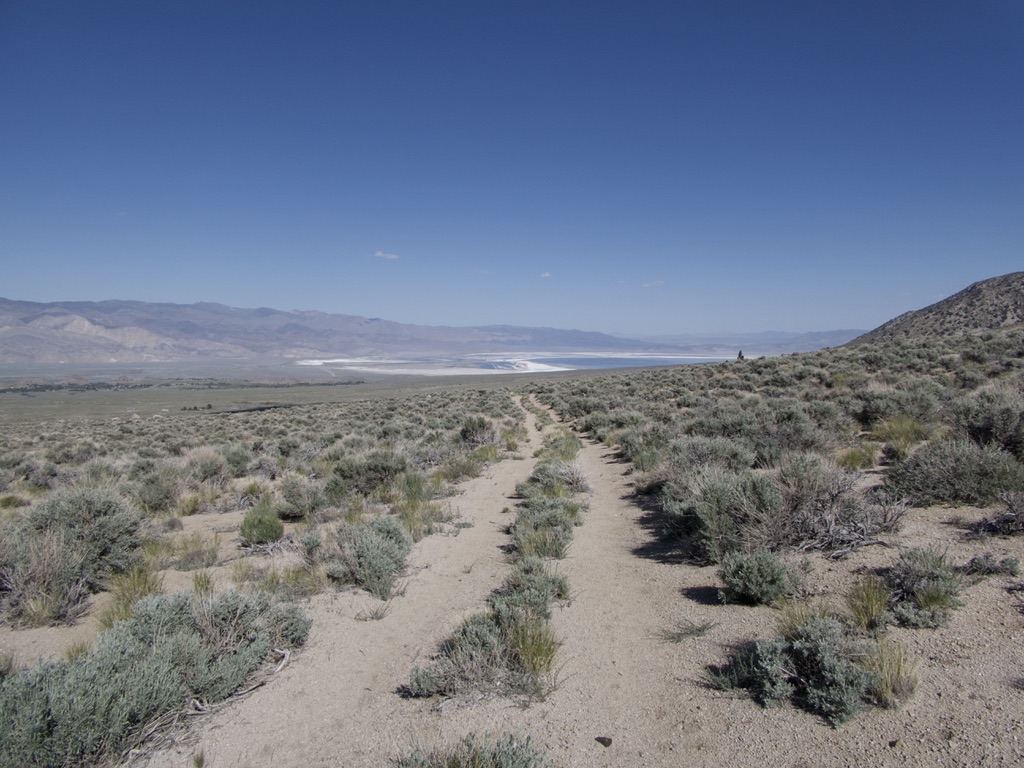
View up the hill to where the final boulders were located:
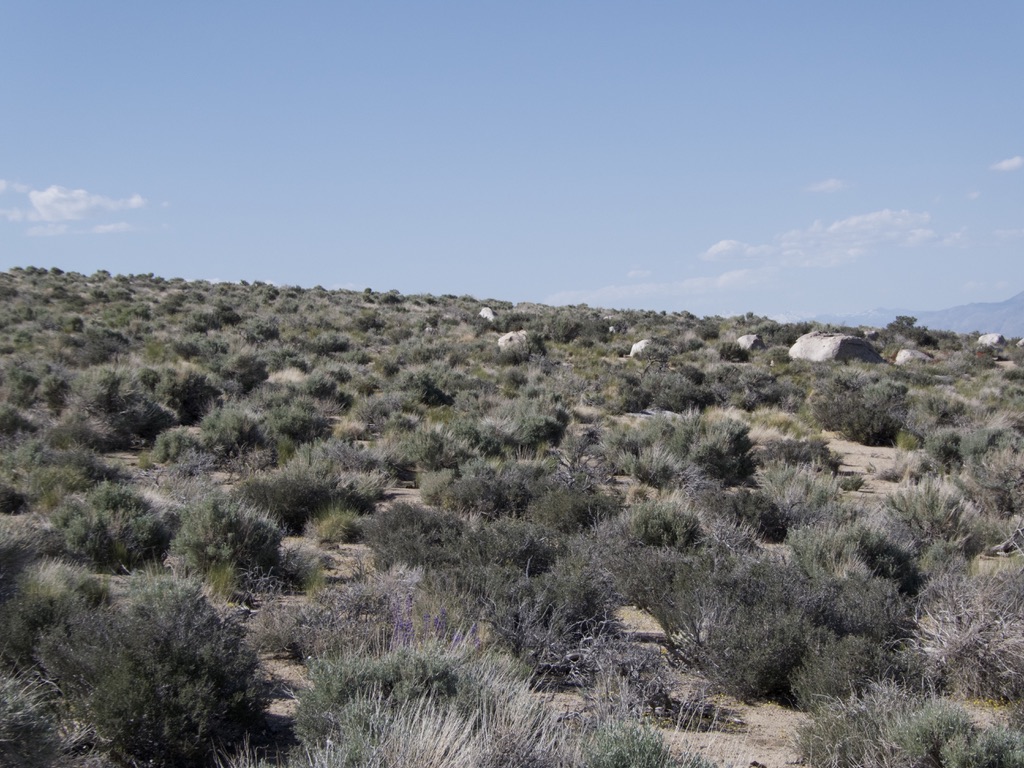
Chunk of the “boulders”, 30+ years on:
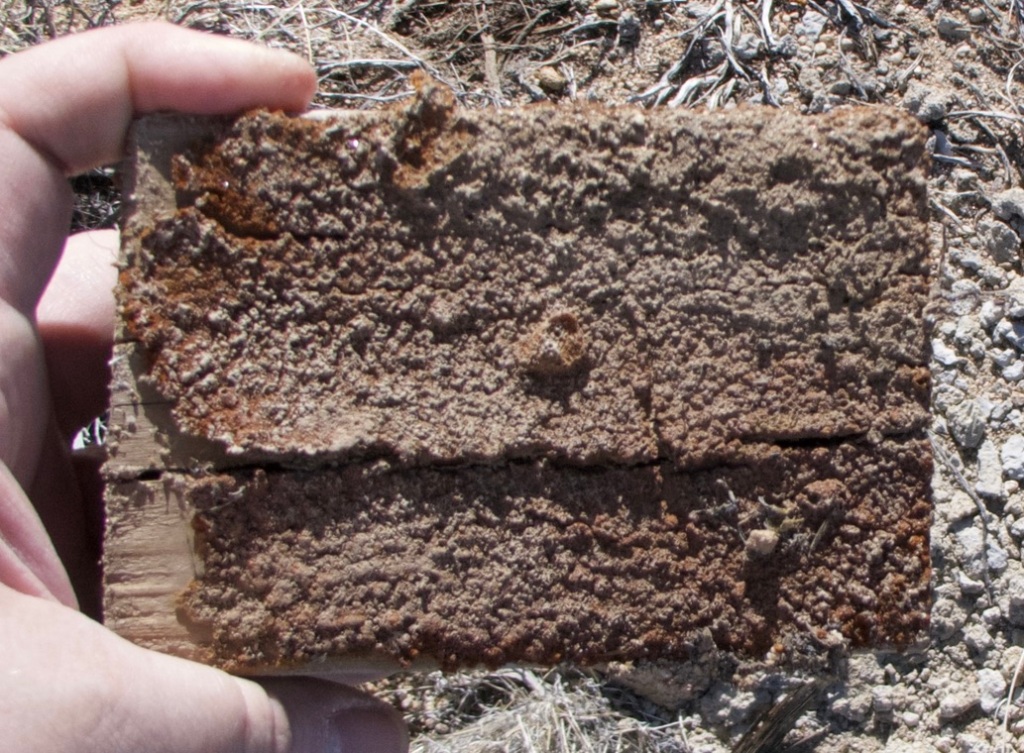
The big “running to the cliff” scene with the three heroes:
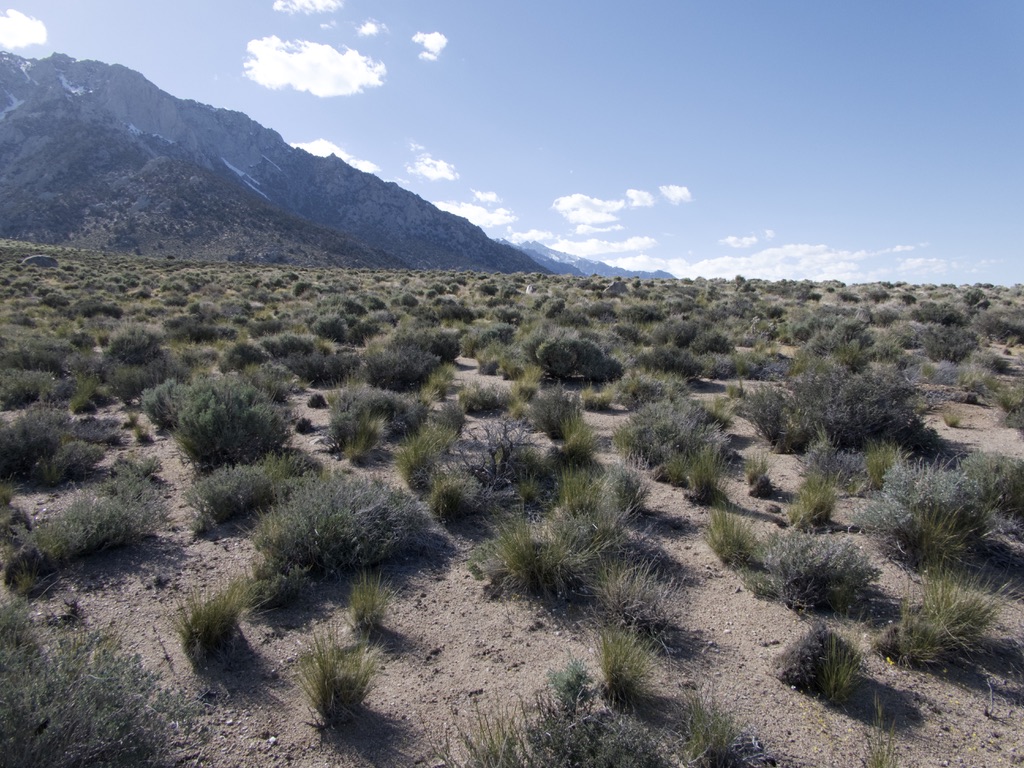
Where we are staying was a painting by Victor Wong, who played “Walter Chang” in the movie. I’ll leave that for you to discover on your own.
Manzanar
The next day we went to Manzanar.
Manzanar was rough. It’s gut-wrenching to think of the tens of thousands of ordinary people who were imprisoned here for years. On our way down we happened also to stop briefly at Tule Lake, which was one of the other ten prison camps for people of Japanese ancestry who happened to be in the U.S. at the beginning of World War 2.
When you come from the north, one of the first sights is a reconstructed guard tower.
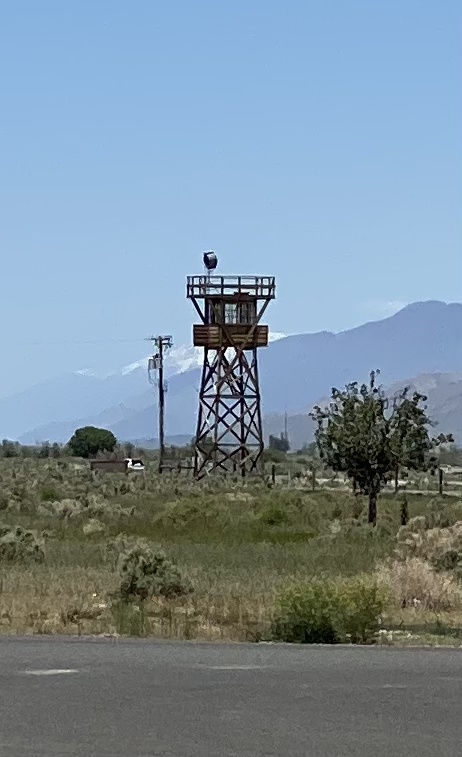
There are dozens of large and hundreds of small reminders of the massive injustices committed, from the small gardens within the camps to the histories about the large farms and weaving sheds (for camouflage netting) staffed by the imprisoned. One of the most disturbing was the cemetery for prisoners who died while incarcerated.
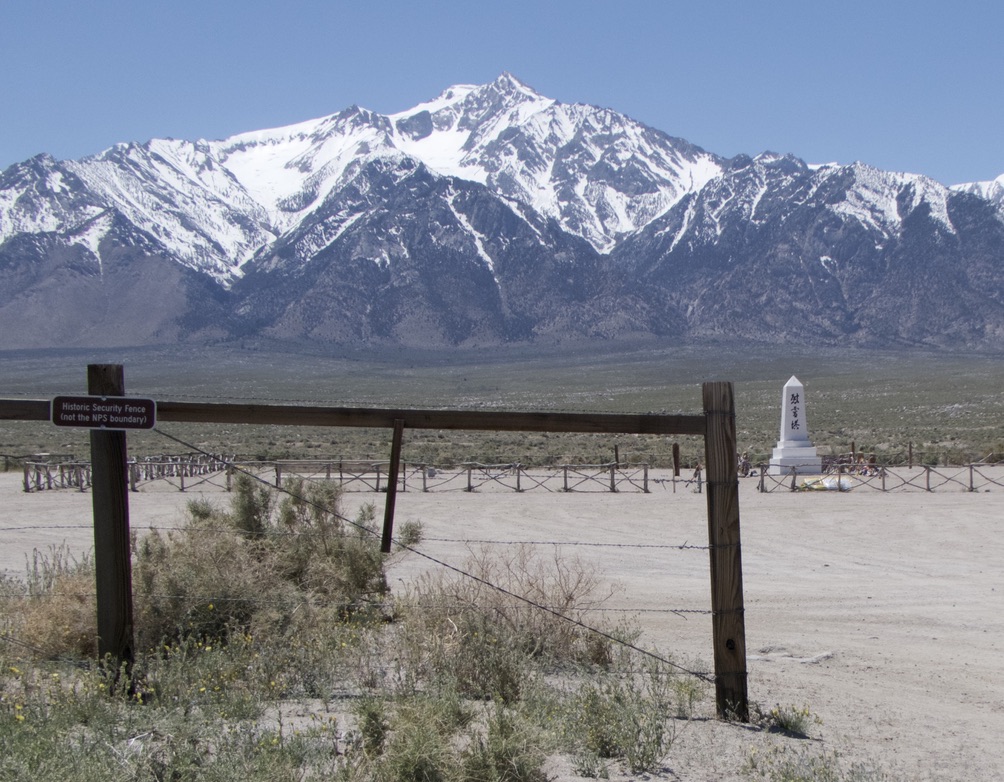
If you look closely at the left side of the photo, you see a sign noting that the cemetery was placed outside the security fence of the prison camp. I can only assume that the survivors did not want their dead family members to be buried within the prison camp, but this also meant that they could not visit the graves at will.
A view of the monument in the center of the cemetery, aligned with the peak of Mount Whitney, the tallest peak in the lower 48 States:

We spent the rest of the day looking for some other movie sites, but we had little provable luck. We did get to try out Clifford’s tires on some really rough roads–if you know the area, we were up Mazourka Canyon Road north of Lead Gulch, where the road (trail, really) split off to the OHV trails. Everything was getting pretty washed-out and mildly technical so we declared victory. We got to test our Morrflate kit in the field, and that worked well; we only went down to about 39 PSI, not really very daring but still a valid test. We might have found the filing site for “Burt and Heather Gummer”‘s house. We suspect it’s on private land north of Kearsage, but very difficult to prove.
Clifford Electrified; or, That Way Lay Madness
One of the big efforts the last few months has been to add a largish “house battery”, meaning a battery for uses other than the starter motor, to Clifford.
Why?
This is one of those projects that took on a life of its own. During The Long Trip last year, we had a small refrigerator/freezer running off a portable 700Wh battery pack. Functionally it worked, but the battery took up a bunch of space in the cargo area, and it’s a pain to strap in safely in case of an accident. And the charging was very hack-y, connected to one of the 12V accessory outlets (some of us might call them cigarette lighter outlets…), which is unsatisfying to an engineer.
Before The Long Trip, I had ordered a set of “seat deletes” and a cargo tray for the back of the car, but they had not arrived before that trip, so the refrigerator was on its slide, which was bolted to a piece of plywood, which was strapped in to the stock tie downs–very sketchy and not at all a permanent solution. The “seat deletes” and cargo tray are big pieces of marine-grade maple plywood with a very durable coating and support structure. After we got back in October we unbolted the rear seats (easier than it sounds) and installed the seat deletes and cargo tray, along with noise-reducing material under it all. This gave us a nice, dry, flat surface to work with; maybe to pot some flowers… I also added some red/white interior lights from Me-So Customs because…why not?
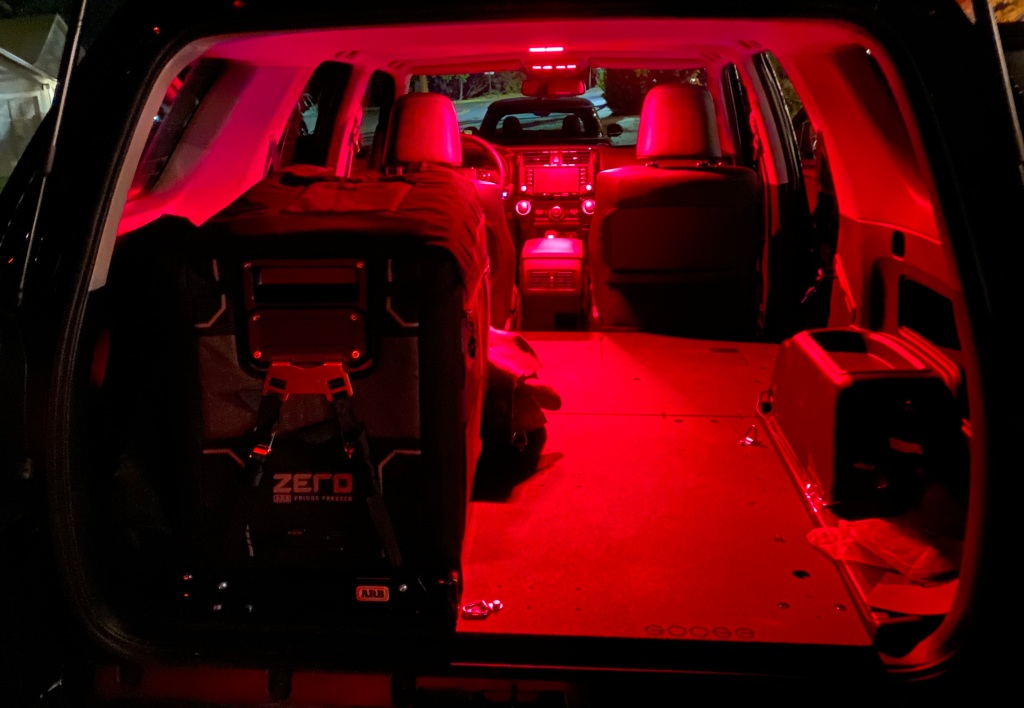

Okay, so you see those small hatches in the second photo? That’s where the madness starts. Those allow access to what had been the footwell of the rear seats, now usable only for storing small objects like window shades or maybe a utility blanket.
At some point I had read something about wanting a compressor to air tires up and down for off-roading. The compressors are looked small enough to fit as a permanent installation in this new storage space. I even built a prototype from plywood to hold a compressor under there as a quick test. But then we started thinking more about the battery for the refrigerator, and how it might be nice if it could run for more than overnight. And what about cooking? We’re not keen on carrying propane inside or outside the vehicle, and the green Coleman cans are an environmental mess (don’t go there…), so what about electricity?
But a microwave takes 1,000W or more, and an induction hotplate is 1,500W.
But there’s quite a bit of space under there…
Jumping way ahead, with many false starts and failures, and I would up at this:
Well shoot, I don’t have a good photo of the system. But it’s a 3,000W battery pack (125Ah @ 24VDC), a 70A 12V DC/DC converter, a big fuse box, 300A battery switch, AC/DC charger, and the compressor that got all of this rolling, all in the space under the seat deletes. There’s a 1,500W inverter for the microwave and other appliances (we haven’t gotten the hotplate yet), and the microwave in boxes above the seat deletes. This is all much more convenient than the original portable battery, aside from the portable battery not having nearly enough juice to run a microwave, etc. And it should be a lot safer: LiFePO4 batteries, very stable chemistry, and all strapped and bolted to the chassis of the car a lot better than the portable battery every was.
It’s a hobby. You also do stuff with questionable usefulness, you know you do.
One of the things we did in Lone Pine, as a field test of the whole system, was to pop a bag of microwave popcorn in our own vehicle, powered only by the new battery pack. A big day for us and Clifford!
On The Way…
Between Lone Pine and our next stop, we stopped at the famous Tehachapi Loop. It’s a famous location on the train route from Bakersfield (and points north) to Mojave (and south). It’s a key element in allowing train travel from southern to northern California. Here’s a cool video of a 4,000 foot train crossing itself as it passes through the loop.
While we didn’t see any trains, we did have a nice lunch of Chinese food from a restaurant in Lone Pine, stored at FDA-safe temperatures in the car’s refrigerator (powered from the new battery bank), and microwaved on site. Not exactly the best tribute to the Chinese railroad workers who built The Loop, but it’s what we had at the moment.
Into The Fire
Not literally, of course. But we were heading into an area of Malibu where the Woolsey Fire had roared through in 2018, burning almost 100,000 acres, including a lot of film studio backlot areas and some really expensive houses, from Simi Valley south to Malibu and west halfway to Santa Barbara. The burn scar is visible from space.
Four years gives time to rebuild, somewhat at least, and the owner of our next stay did so in grand style, transforming a narrow mountain peak into a personal-sized resort.
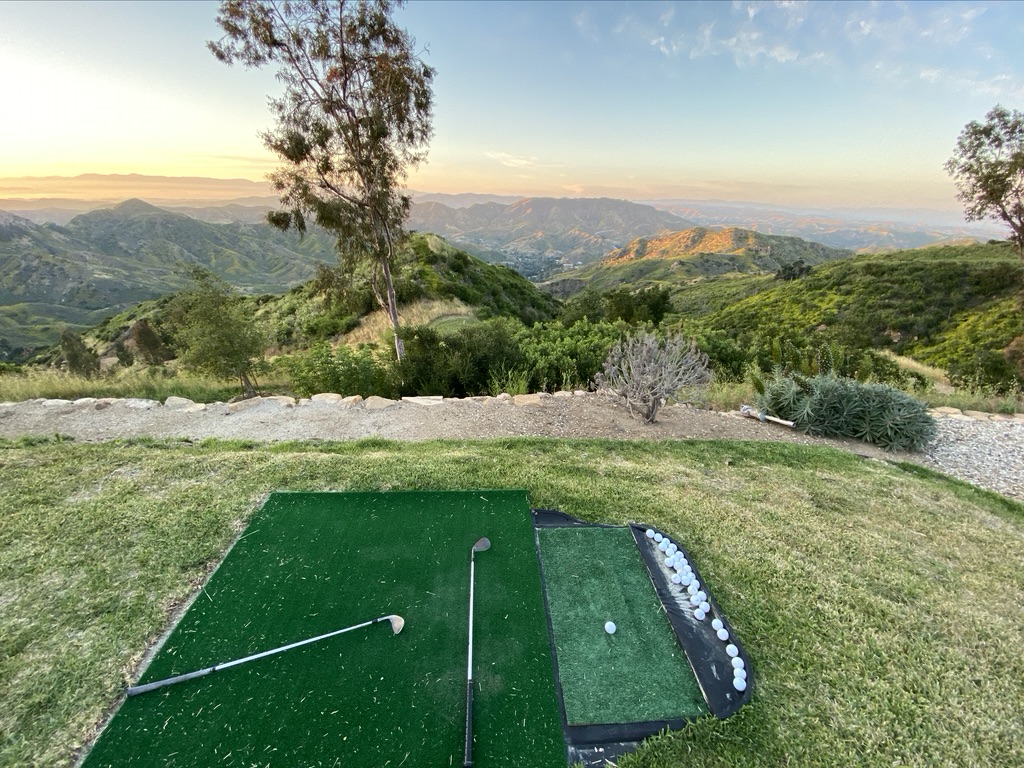
If that view looks familiar, it should; the movie and television series M*A*S*H were filmed very near there; I can imagine Hawkeye, Trapper John, and Colonel Blake teeing off from this spot.
Here’s another view, from up by the “tent” that is the main accommodations:

The “tent” is one in name only because it has a fabric roof and outside shower; it has solid walls, a very fancy kitchen, large screen TV, good Internet coverage, a full-sized stacked washer and dryer, and the most comfortable king-sized bed we’ve ever tried.
Here are some more:

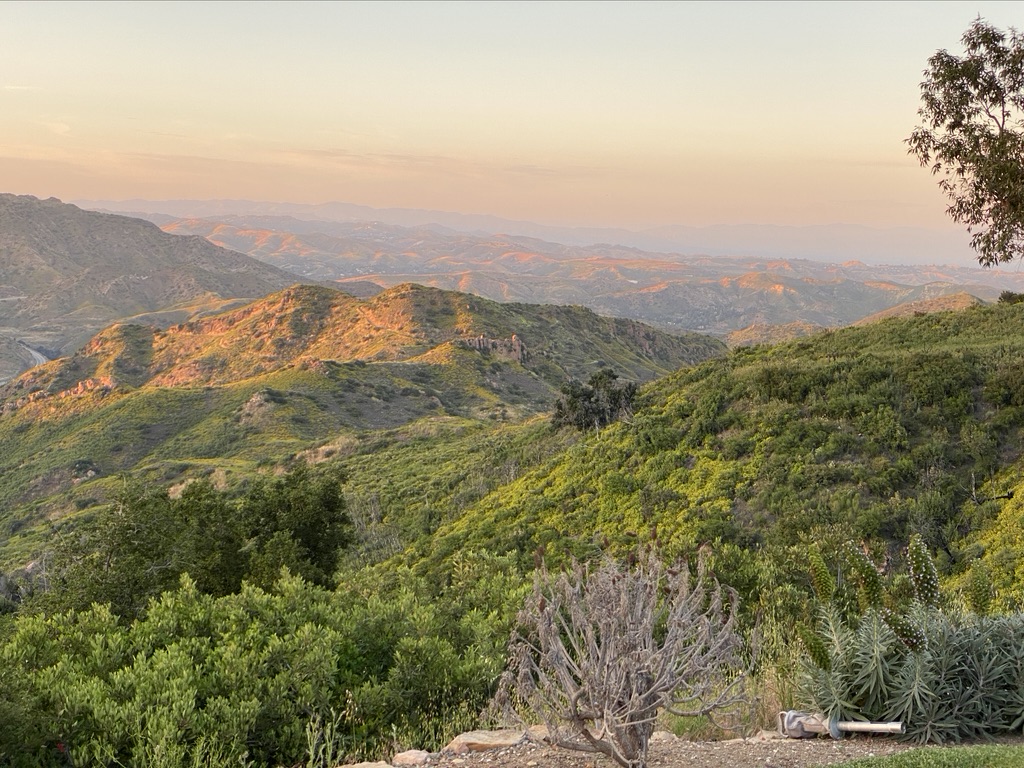


The pool has a waterfall (three, really). And a jacuzzi, and cabana, and pool house with another huge TV and full bathroom.


Being up in the hills, there’s plenty of wildlife. Some iguanas, an owl, and a bobcat dropped by.
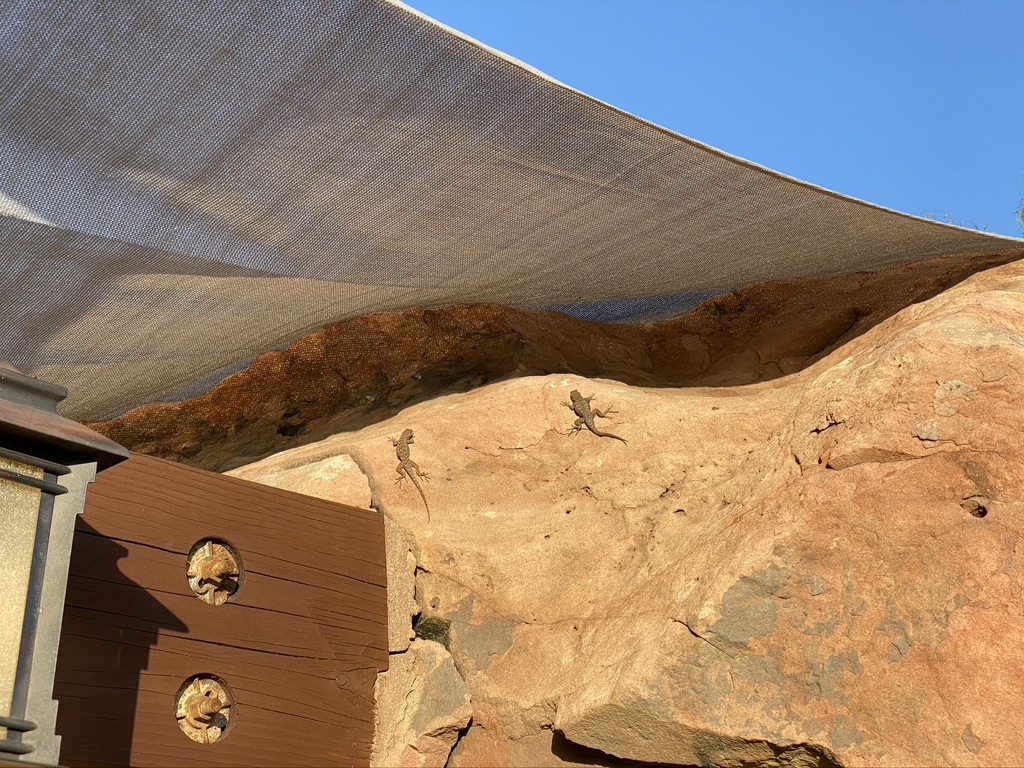
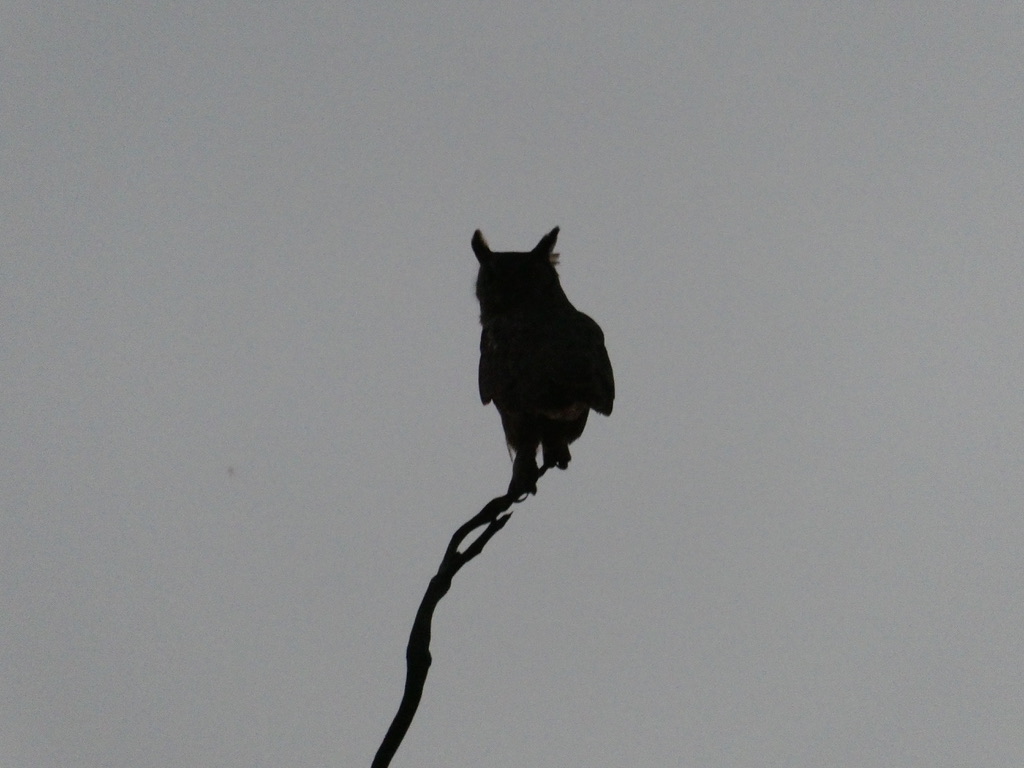

The drive up and down is interesting in a “may you live in interesting times” kind of way. We had to confirm that we have four‑wheel drive at the time of booking, and again when we were met at the rendezvous down the road (the famous Malibu Rock Store, legendary biker hangout) by the caretaker for the drive up.

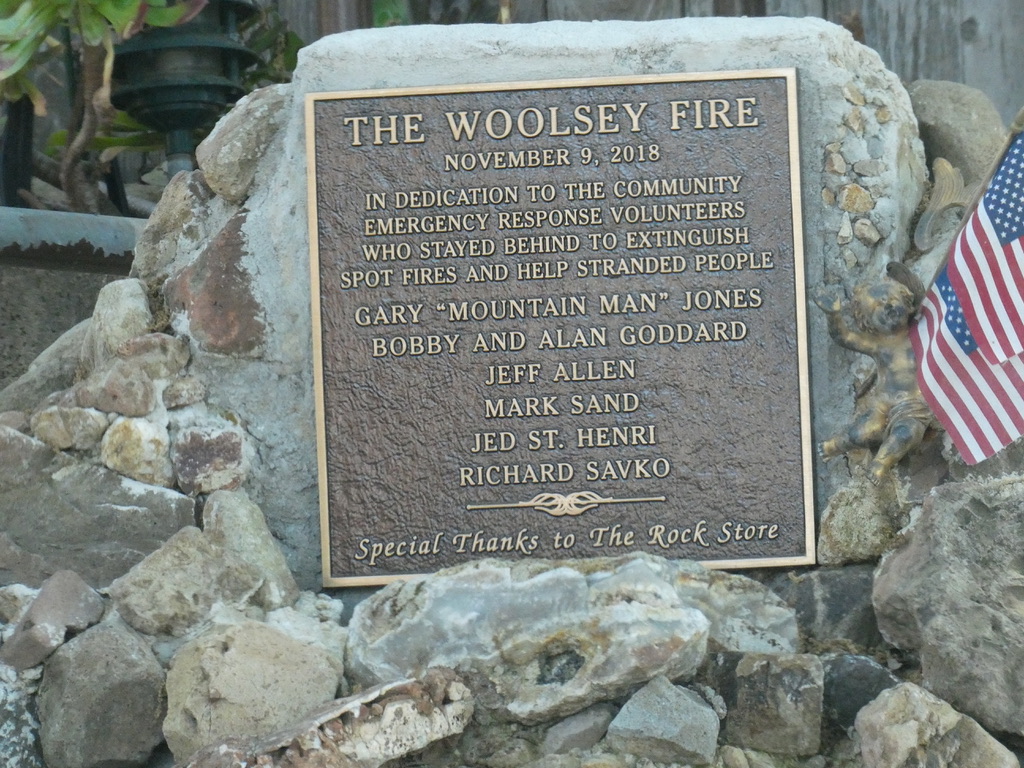
The dirt road up to the house is about 10 degrees on average; parts were much steeper. Clifford had no problem with it, but I would hesitate to try it with the BMW, AWD or no. Apparently a helicopter flight from a local airport is the jet-set way to get to the top, but what we did worked just fine.
Over The Bridge And Turn Left
One of the reasons to stop in that part of Mailbu is that it’s very close to Malibu Creek State Park. That doesn’t sound like a place worth detouring to, but a big part of its grounds were originally the Fox Studios “Fox Ranch” sets, where dozens of Fox-produced films and TV shows were shot. Many exterior scenes of TV shows like “The Rifleman” and “M*A*S*H” were filmed there, along with exterior scenes from a host of Fox movies.
I was there mainly for one film, based around this house:

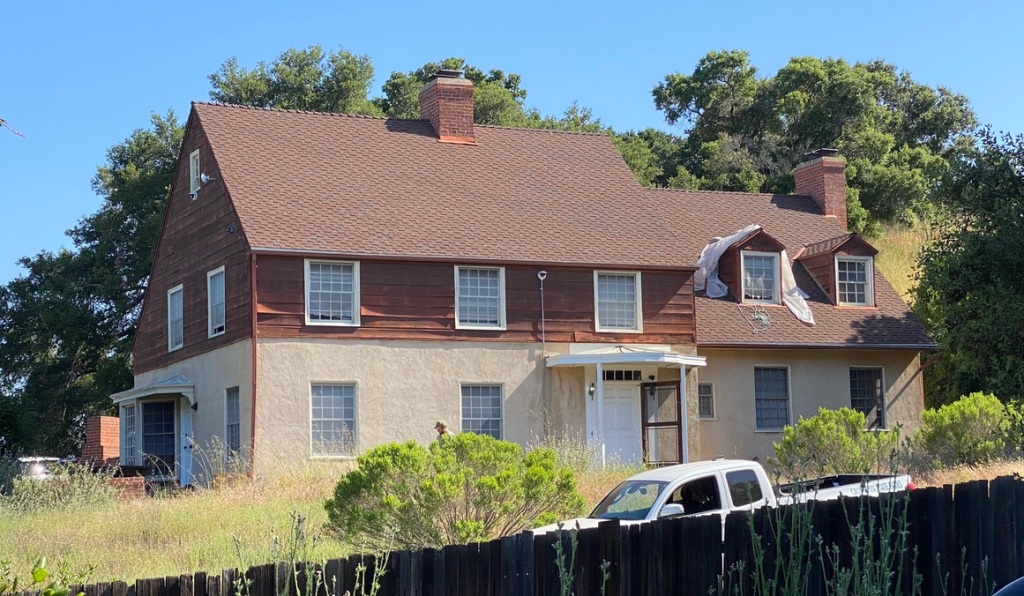
Doesn’t look familiar? Imagine it in white, with black shutters, and a 1940s family on the lawn:
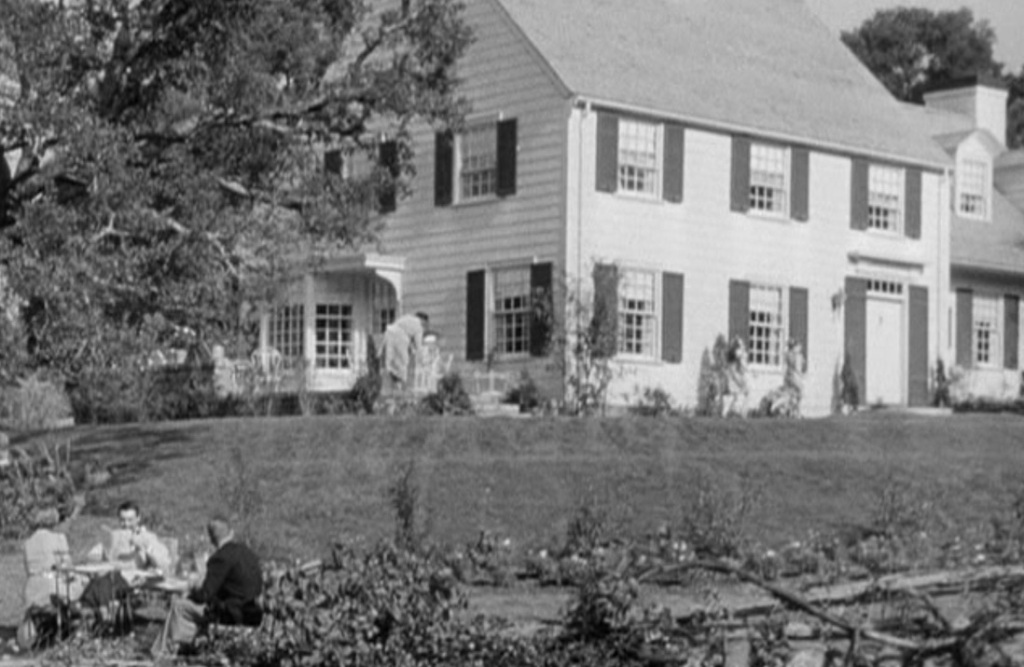

Yes, it’s the house from Mr. Blandings Builds His Dream House (1948). While there was a replica built in Connecticut, and 73 more were built across the country and raffled off as a promotion for the film’s release, this one in Malibu was the one built and filmed for the movie. It’s now the park administration building, so there’s no getting inside, but it’s great just to be able to see it from this vantage. The landscaping is a lot more typical of Malibu than Connecticut, too.
Vince Gauraldi Is One of My Favorite Artists
Okay, that’s a weird play on a “Mary Tyler Moore Show” episode title, because we were in Minneapolis last year on The Long Trip and saw The House, and because Vince Gauraldi wrote a tune called “Pebble Beach”, one of his iconic “Charlie Brown” songs.
The weather was not as good as last May when we were in Monterey, but the views were still excellent.
Views from the Pebble Beach Lodge:
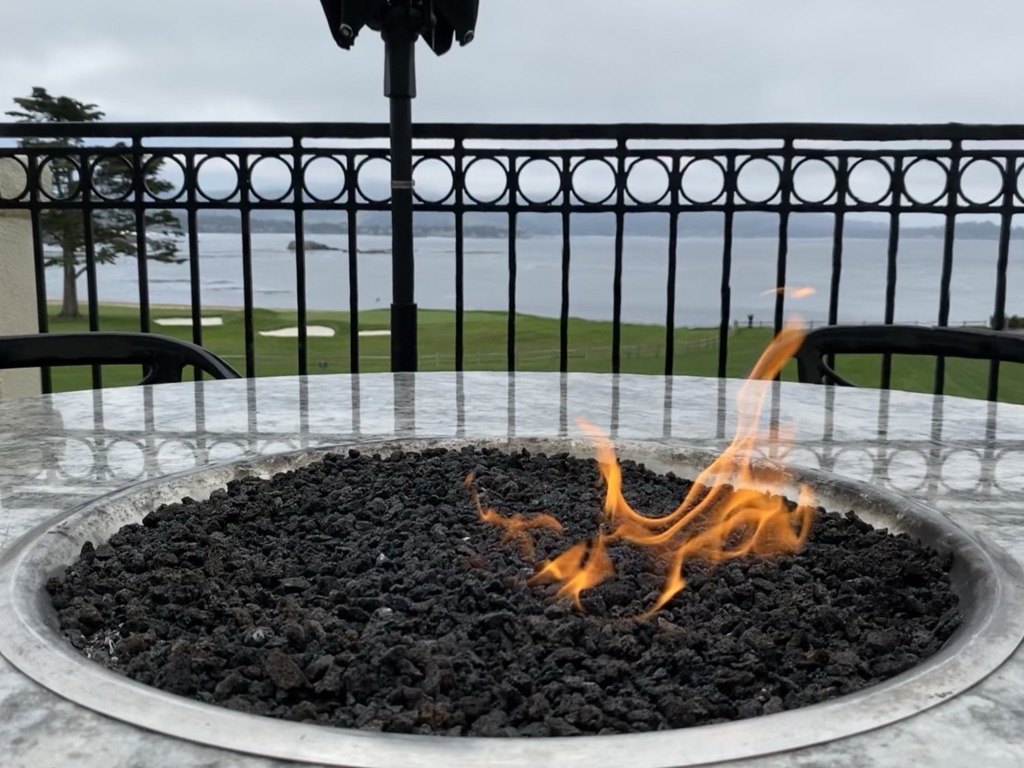

The Lone Cypress, along 17 Mile Drive:

An old building in Carmel-by-the-Sea:

The outside of our B-and-B in Monterey:
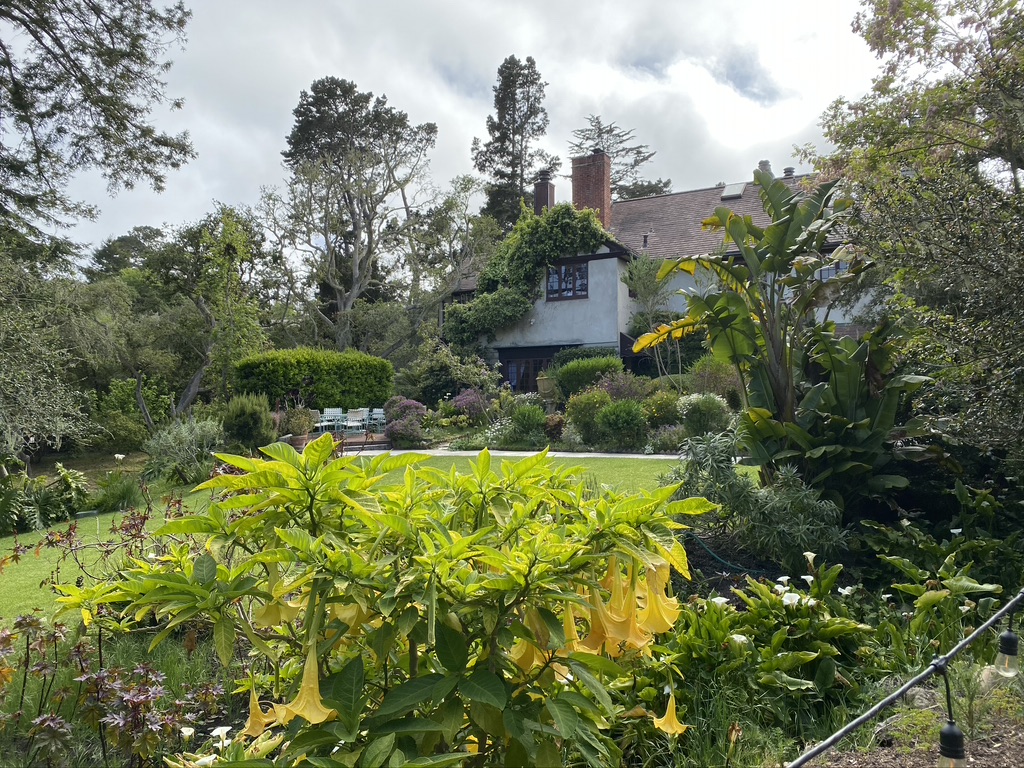
We had a great dinner, one of the best in several years, at a restaurant in Carmel-by-the-Sea called Chez Noir. They got a well-deserved write-up at eater.com; definitely check them out if you plan to be anywhere near there.
Our Continental Cousin
One of the places we really miss not being willing/able to travel to is The Harpy, a large barge on the Thames that was converted into offices and then lodging by the owner. There was a brief shot of it in the film A Fish Called Wanda, looking over it from the balcony of the apartment used by two characters in the film for their trysts. It’s the red-roofed vessel in the lower right corner:

It’s roomy, comfortable, and has magnificent views of central London.

But that’s for later times. Still, it would be nice to find something like that closer to home, maybe within driving range…
Remember how I said I spend an outrageous amount of time planning trips? Yup, did it again; result!
It turns out that while The Harpy was being restored in London, a family in Sausalito had rescued an old ferry boat, the former “Spirit of Seattle”, from the dregs of the Oakland estuary and converted it into the family home. Decades later and some of the family who still live on the boat have split the space to share as a vacation rental.
It’s an enormous place; the rental space is over 2,500 square feet, and the whole boat is closer to 6,000. The engines and other equipment have been removed so all of the interior is livable space. Enormous timbers frame the rooms; the floors are massive Douglas Fir planks. There’s a solarium that occupies the rear deck.
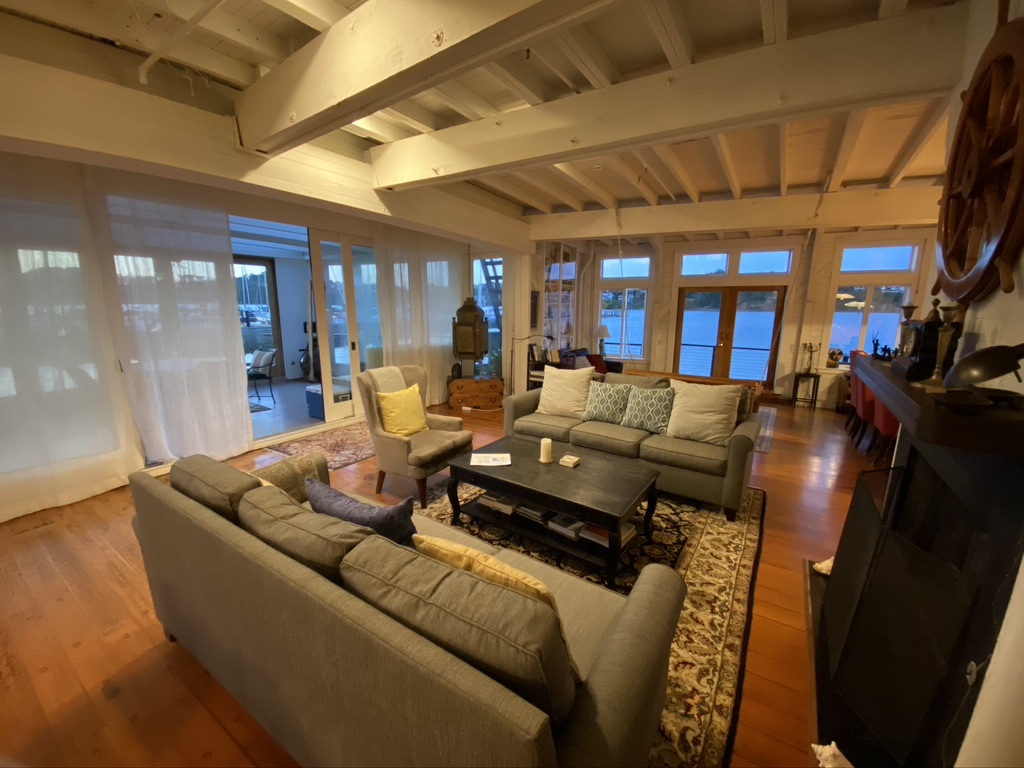
While the views aren’t of the Tower Bridge, they are still excellent:


Sausalito, or at least this part of it, is very much an extension of the more colorful parts of San Francisco. The people who own the ferry also own that dock, which has another twenty or so smaller houseboats arrayed along the dock. This one looks like it belongs in Tales of The City.
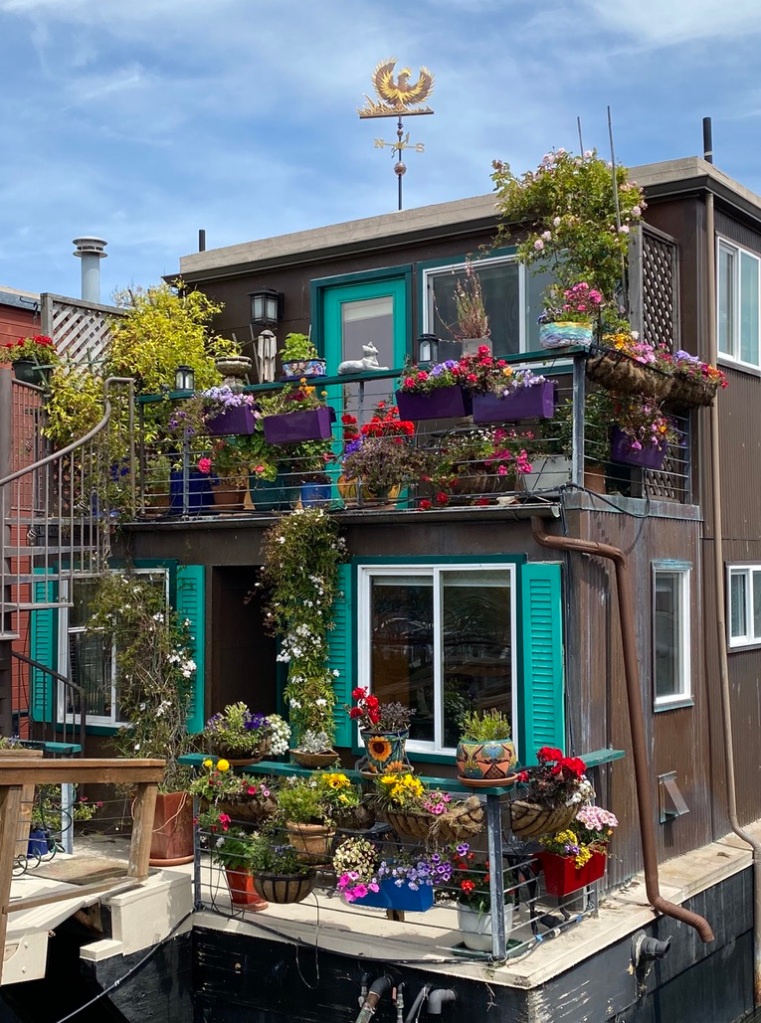
We have no idea why a statue of an elk would be on an auto body shop, but there it is:
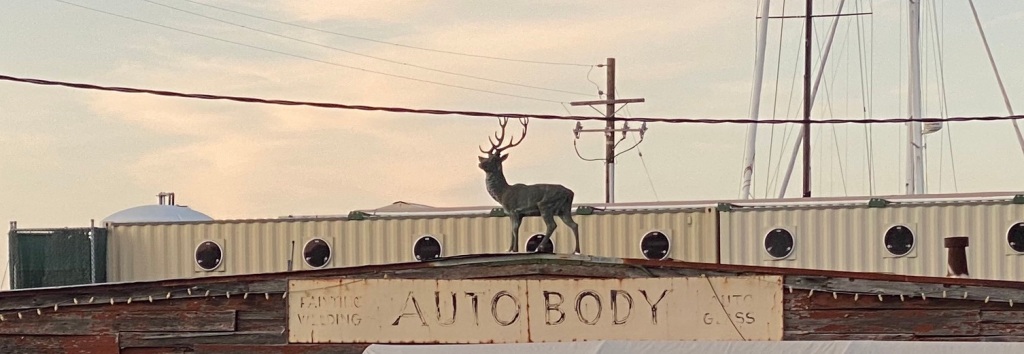
And yes, all PT Cruisers should have white walls and red wheels:

If I were filming Silence of the Lambs as a water-borne remake, this is the boat where I’d set the villain’s creepy lair:
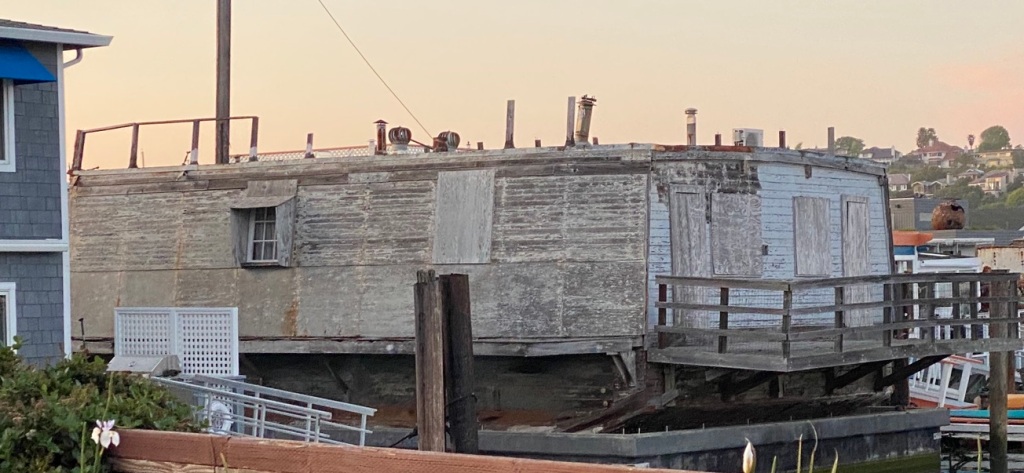
Excellent Covid-precaution theming!

And Home Again
We cut off our trip after Sausalito; the weather wasn’t as good as last May, and it just felt like a good note on which to end. On the way home we did stop for chowder near Bodega Bay, where this figure stands watch:
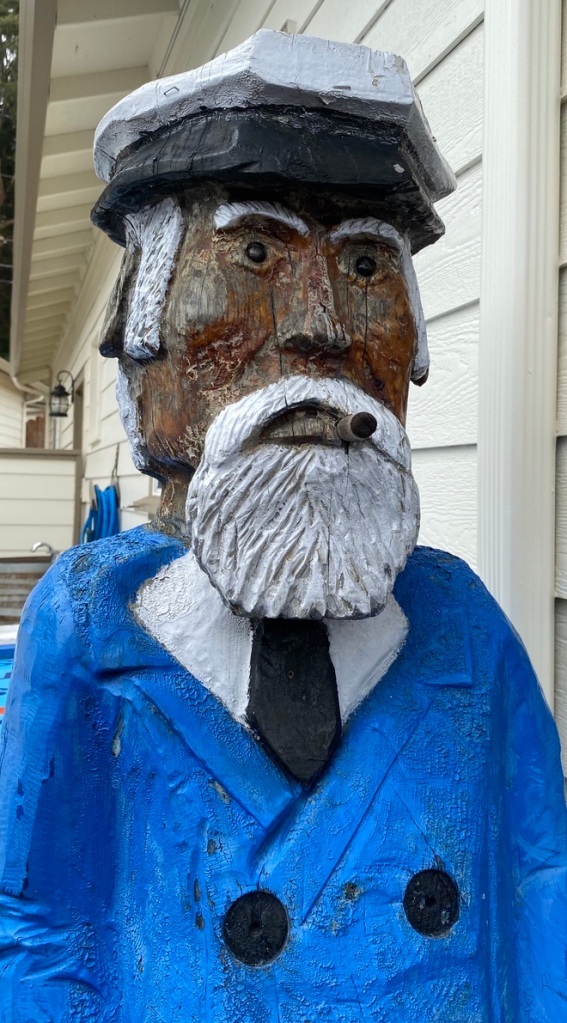
With Clifford’s new electrical system, and some future additions that we’re planning, there will definitely be more road trips ahead!
A Drive To The Snow
We have a new(ish) vehicle with four-wheel drive, all-terrain winter tires, and snow chains. Road trip!
It’s been snowing on and off in the mountains around Ashland. This is normal, and not in an ironic way; it’s how Oregon stays green much of the year. But it rarely snows much in the Valley; if we get an inch or more that sticks through the day, that’s an event.
Snow is great. It’s pretty, it’s cold, and it’s very handy for making snowmen.
Show is terrible. It’s cold, it’s wet, ice trips you up and breaks your bones, and many people die each winter from heart attacks after shoveling it, which is a mandatory activity several times every winter if you live around the stuff. Snow is one of the reasons we moved to the West Coast.
But it’s nice to look at, and fun to tramp around in occasionally.
Crater Lake is a place we’ve been to many times. The lodge there is only open May through October because it’s too expensive and difficult to keep staff there all winter. Most of the winter the road around the north side of the rim is closed; at least a few times the in winter even the road up to the rim from the main park entrance is closed by snow.
We had been to Crater Lake when there was snow on the ground; one July 4th there was snow well over six feet deep by the side of the parking, and it snowed while we were there. It’s a joke among the staff: “When does it start and stop snowing at Crater Lake? It stops in September and it starts in September.” Apocryphal, but only just so; at 7,130 feet above sea level, it can and does get down to very low temperatures all year.
Oregon has a system of traffic cameras statewide called TripCheck. It’s really handy, because it shows the conditions of the roads in the backwoods as well as traffic in urban areas; you can at least get a sense if a pass is full of snow or not. We used it, and the webcams at the park itself, to see if it looked safe for us. Cameras for the route looked good. Webcams only show what’s in front of them, however; they can miss things, like this really big slide on US101 a couple of weeks ago.
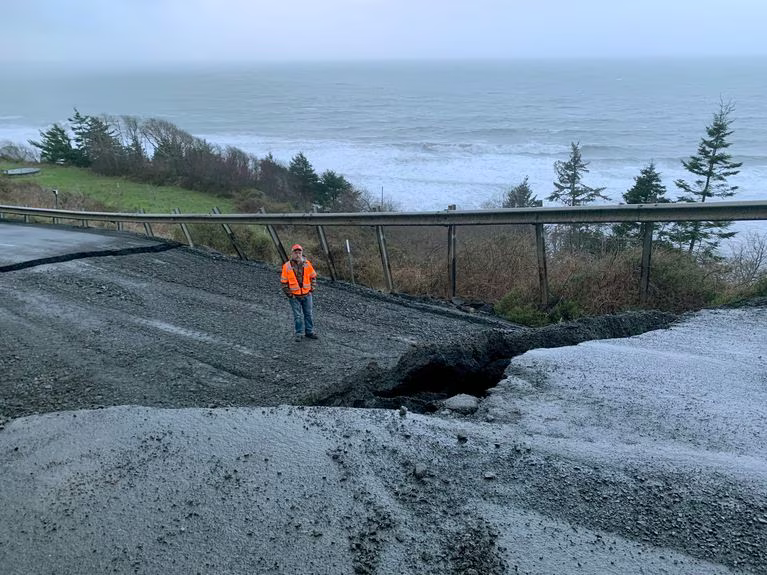
The webcams at the park were showing packed snow on the roads, and really high snow–maybe eight feet deep–alongside the road. No cameras were working up at the rim so no way to know what was going on there.
No matter. There being the aforementioned snow, and the aforementioned vehicle, we declared road trip and headed out.
Most of the way up to the main road to Crater Lake the road was clear. When highway 62 turned east, towards the south entrance to the core of the park, that changed. Lots of loose gravel or maybe cinders (for traction on ice) on the road. Snow building up along the sides of the road.
Very quickly the snow started to get packed on the road, and we entered what we called “the luge”, which is probably totally normal for folks who live in the area above about 5,000 feet but not for us:


So that was interesting. The snow next to the road was six feet high or so.
When we got to the park, the ranger at the entrance actually checked our tires to make sure they were snow-rated (they are) and to let us know that the ice on the road was starting to break up, which sounds like a good thing but really isn’t.
At the bottom of the road up to the rim, we took this photo. Note the other vehicle and hikers in the background for scale.

The drive up was, despite the Slushee-like ice at times, uneventful. There was a very slow Jeep in front of us with a driver who was either very intent on observing the snow, or a bit unsure of their abilities. I’m guessing the latter.
At the rim, the lodge was closed but, of course, the gift shop was open. The gift shop building has a very Shining-esque look even in mid-day:

The snow was, as expected, about eight feet deep and densely packed where it hadn’t been plowed. People were climbing up on the snow, as we were later, as that was the only way to get a view of the lake. Some cars for scale:


The climb was a little steep: no steps, just a ramp beaten into the side of the snow hill by other visitors. But the view was well worth the climb, and the drive:
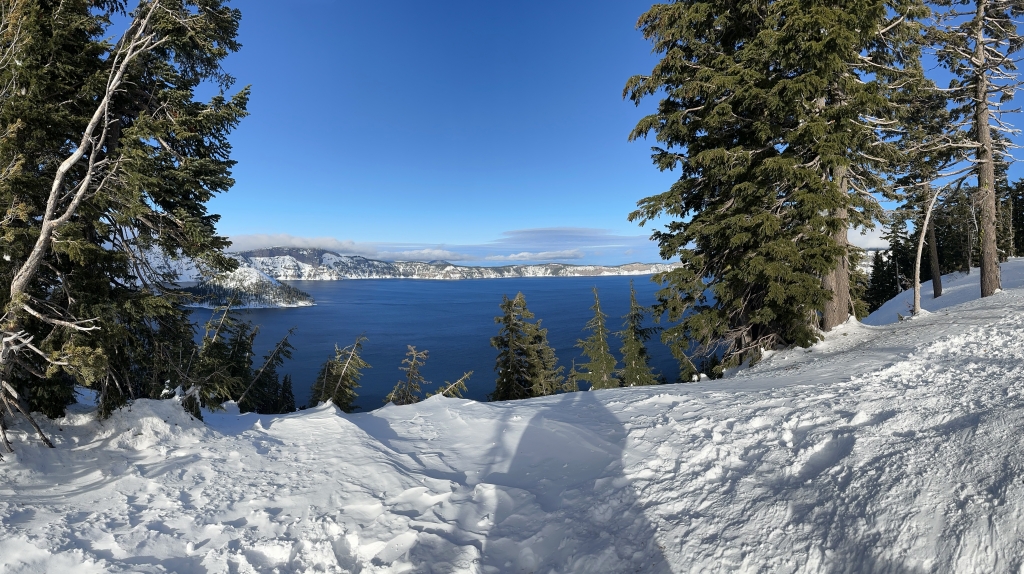

The lodge, closed for the winter, also had that Shining look:

The drive home was also uneventful, and went faster; isn’t that always the way? But we had a lovely sunset about halfway back:
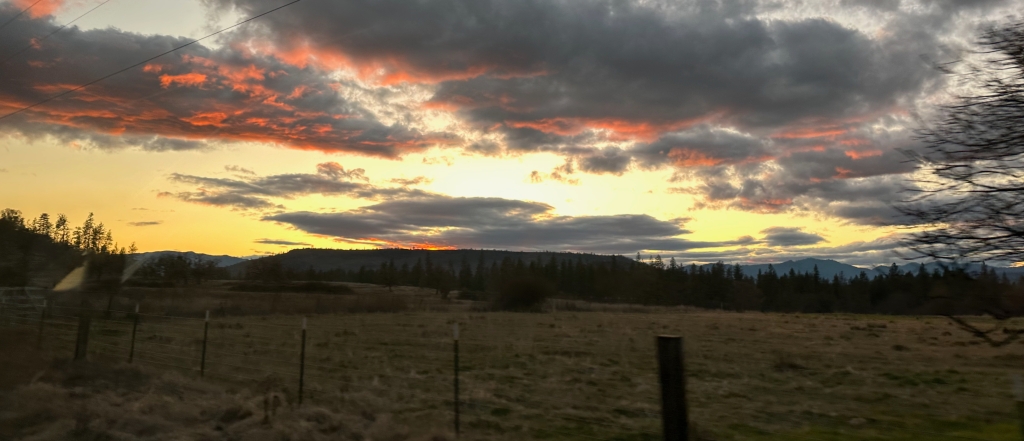
That’s all this time. More drives later in the year, maybe.
So It’s Been A Minute…
So it’s been a while since I posted anything. We’ve stumbled our way through 2022 and here we are now. This post will try to catch you all up.
TL;DR Mode
We bought a new(-ish) vehicle, drove cross-country to visit relatives, and have still avoided catching Covid so far. We also made some shorter driving trips into California. Kind of a busy year. We watched a big chunk of the Star Trek TV franchise. Now we’re watching a lot of classic movies and TV at Christmas.
What We’ve Been Doing
It’s been another Covid-dodging year; we’re still good so far, touch wood, but we’re also bizarrely privileged for this situation: no children to bring Covid home from school; no job obligations requiring on-site work; no familial requirements except a recurring desire to see relatives and friends, but an unwillingness to bring harm to them or us in doing so.
We did take a very long cross-country driving trip to see relatives back East who we haven’t seen since The Before Times. Three-and-a-bit weeks, about 100 hours actual driving, both world’s largest balls of twine, a passel of house rentals from amazingly good to outrageously bad, more gas burned than in the prior three years total, and a whole lot of takeaway. More on that later.
Cars, and Sharing, or Not
One of the weird things about us (stop it…) is that we generally don’t drive each other’s cars. A very long time ago, when we had first moved to California, we went to a restaurant where there was some dish for two; fajitas, I think. We had some back-and-forth about how to order them–flour or corn tortillas, steak or chicken or both, what kind of veg. After a few minutes of this, the waitress advised: “You two should never get married.” 35+ years on we still aren’t, but we are still together.
But we have learned is what we do and don’t share. Cars have generally been in the “don’t” category. Herself mostly drove The Original Volvo, because I didn’t know how to drive until a couple of years after we moved to California (yes, really). Sometime later we got Vern the Mercedes, who lasted only a few years, and then The Red Volvo, which became mostly mine and Herself drove The Original Volvo until that car met with an unfortunate end (not her fault). We had another Volvo (Egg) for a while, and then Herself mostly started working from home and the Red Mercedes came out with Henry and Vern went back East with him, so we had two red cars. And then we moved to Ashland full-time, and cars became less significant for a while–no kids, no commute.
But then we moved to Portland and I needed to commute again daily. Around mid-2015 I satisfied Male Mid-Life Crisis #1 (ok, maybe #3) with a new BMW convertible, but a very practical (!) one: AWD with summer tires for summer and winter tires for winter, a hardtop so it could safely be parked outside if needed, automatic cruise control for easing long driving trips. I got Herself a Mini Cooper that she had been eyeing for some time; there’s a whole’nuther story about that. So then we were a four-car couple (don’t…) but we still only each drove our own cars: me, the red Volvo and the new BMW, and her the Mini. We both drive the Mercedes but, at her age, the 13-mile trip to Medford is A Big Trip so she generally stays in Ashland proper. But being a Mercedes diesel, the engine at least will outlast all of us.
I Have Many Plans
Sometime in late 2020 or early 2021, after it was clear Covid was staying around for a while, I started planning a coast-to-coast driving trip. Many, many spreadsheets, with names like “The Melbourne Method” and “The Quick Way” and “Dumbo or Die” (bonus points for getting those references) were created to try to optimize a cross-country drive based around a solo driver.
A key problem with the coast-to-coast trips was the We Don’t Share Cars factor; a solo driver trip was going to take weeks or longer each way. Even though both of us are from the Midwest, neither of us ever developed that tolerance for crazy long days of driving. And, truth be told, Midwest driving trips are sprints of many of hours but few days, not the kind of marathon we were contemplating. No hotels need apply (Covid), and working around 8-to-10 hour driving days was complicated by the general lack of Airbnbs etc. at those intervals. So the coast-to-coast trips stayed on the shelf. Renting a car for 3+ weeks wasn’t really practical; even with 2 drivers, it’s still about 6 days just driving each way. It’s also a huge chunk of vacation/unpaid leave time.
Short Trips Don’t Pave The Way To Hell, Maybe
This process got me thinking about driving trips focused on areas west of the Rockies. We made a couple of trips to Northern California starting in mid-2021 during the lulls, mostly along the coast to places like Mendocino and Eureka. Lovely little towns, lots to talk about there, but also other stories.
The longest trip we took, during a lull earlier in 2022, was a long loop along the eastern side of the Sierras, down to the general Los Angeles area, and back up along the coast. I drove that in the BMW, because (1) great weather plus (2) back roads that are fun to drive plus (3) a fast convertible. Especially along the coast, it was absolutely the perfect car for the trip. 17 Mile Drive, for example, is excellent most of the time anyway, but a truly epic drive in a convertible.
One of the parts of the trip where none of our cars would be the best choice was a part near Bishop California. If you’re familiar with that area, you may know that the Alabama Hills area near Lone Pine has been used since the 1920s for exterior sets for movies, mainly westerns but also films like Gunga Din (1938) and Tremors (1987). It’s gorgeous country, but very much gravel and washboard dirt roads. We got to some of what we wanted to see, but there was a lot we had to pass up because we just didn’t have the kind of vehicle necessary for the roads and not-roads.
A Roving We Shall Go…
I had been looking at four-wheel drive vehicles for a while, probably as planning for that trip. Renting them is essentially impossible, and if you break a rental off paved roads, you’ve bought it.
Of course, the last year was probably one of the worst on record to buy any vehicle: Covid-created shortages in new car availability created crazy markets for new and used cars. So of course that’s when I chose to try to buy a car. ¯\_(ツ)_/¯
I’ll skip the details, but after months even after we knew what we wanted, we found Clifford the Big Black Toyota 4Runner. Yes, we know Clifford is supposed to be red but don’t harsh our ride. He had been left at a Portland-area BMW dealer (kizmet?) as a trade-in. One of the things that sold us is that Herself took to him immediately in the test drive, which surprised the heck out of both of us (Herself more than me, I think). It’s a vehicle with a long production history, lots of user communities for support, and exceptionally good off-road capabilities.
A Car For The Whole Family
What I never realized about that expression was that in this case, it meant we could haul two or three families, and pets, and their households; it’s huge on the inside and outside. We started putting luggage, and groceries, and even a portable refrigerator in it, and it still had tons of space.
But even more so this is a vehicle we are both comfortable driving, on-road or off. This was a big surprise to both of us, particularly a couple of occasions when we had to take dirt and gravel roads and Herself was driving it, and really liking it. Who’d have thought it?
We had finally broken the We Don’t Share Cars Conundrum.
A Really Long Trip
So now a long cross-country was actually possible; instead of it being four weeks or more of agony for one driver and utter boredom for the passenger, we now could maybe do it in three weeks.
Much more planning ensued. First I planned and booked it one way–northern route eastbound, central route for return–and then changed it completely around a few weeks before leaving because it turned out that the best way through Rocky Mountain National Park, the famed Trail Ridge Road, might be closed for the season by the time we would reached it on the return. Not to be missed!
One of the best parts was the pretty surreal daily realization that we were driving across the country, in a big truck (it’s a truck, not a car). An exclamation of “we’re driving through <wherever> in a big truck! Aaaaahhhh!” became a daily event.
Jokes about “world’s largest ball of twine” that weren’t turned out not to be jokes in the end: there are two, and now we’ve been to both. All three Geographic Centers of the United States (48 vs. 50), including the really off-road one out in a field in South Dakota, done. Iconic TV locations–Mary Richard’s house and downtown Milwaukee “Mary Tyler Moore” show filming sites; the “Mork and Mindy” house; Devil’s Tower, Rocky Mountain, and Badlands National Parks, all seen and somewhat tromped through; countless other less famous sites and places that have meaning only to us, too numerous to list.
We learned a lot about our driving tolerance. The original plan had 8 hours or less as a “short” day, 8 to 10 as a “medium” day”, and 10 to 12 as a “long” day. Our new limits are now 6 for “short”, 6 to 8 for “medium”, and 8 to 10 as “long”. After one very long day, Rapid City South Dakota to Park City Utah, with stops at two of the Centers of the United States locations (official and actual), plus a walk around Devil’s Tower on its surprisingly difficult loop, we have new ideas on what makes an objectively good-but-long day versus a bizarrely long one.
Would we do it again? Probably, but not soon. It’s still 3 weeks plus a bit, allowing for most of a week at the far end. There’s the trade-off between seeing things along the way, meaning more side-roads, stops, and generally not rushing it, or cutting a few days (but only a few) off that and doing nothing but driving, eating, and sleeping. We know our limits better now, and the longer, slower way is definitely better. We’re also encouraged to do more off-road and side-road travel, since we have a vehicle that’s far more capable of that, and I’ve taken modifying it to be even more so; but the details of that are, again, another story.
To Lazily Keep Going…
We’ve continued watching the “Star Trek” franchise in chronological order. I mentioned this in prior posts, and we’ve made good headway since. We’re now well into season 6 of Next Generation, which means we’ve also started Deep Space Nine. Now, we still think the concept of that show is a complete rip-off of the concept of Babylon 5; two independently-created shows about space stations that are diplomatic missions among alien races? Please.
But we are completists if nothing else, so here we are, almost half-way through the full list of episodes (374 of 789). We sped up a bit but are now taking a break for the holidays, so we can switch to…
What We’re Watching For The Holidays
Eighth Street Cinema, like other classic theaters such as Stanford Theatre and Seattle Cinerama, remains closed for a while longer. In lieu of showing films we’ll have to remain satisfied with talking about them.
We seem to have wandered into various daily themes for viewing this year. TV shows during the day, or when we just want something Christmas-y on in the background. Lots of The Bob Newhart Show, My Family, WKRP, Vicar of Dibley, that sort of thing.
One night we had a “Scrooge”-fest, with movies based on Dickens’ “A Christmas Carol” from 1922 (silent), 1938 (Reginald Owen, the Lockharts), 1951 (Alistair Sim classic), and 1988 (Bill Murray, Karen Allen). It was interesting to see how the story changed with different productions; in earlier versions, Scrooge’s former girlfriend is non-existent.
Incidentally, it seems Dickens himself was quite a piece of work; watch “Mrs. Dickens’ Family Christmas” sometime if you can; very entertaining, hosted by the always humorous Sue Perkins.
One evening we watched all classics: Christmas in Connecticut, Miracle on 34th Street, The Bishop’s Wife. A veritable trifecta of Christmas schmaltz.
Last night’s theme was Xmas Horror, so we had the always excellent Night of the Comet, which is set just before Christmas and has a number of Christmas plot references; then Anna and the Apocalypse, a Scottish Christmas zombie musical that is just amazing all the way through, if quite a bit grim and gory; and Finnish-ing up with Rare Exports (see what I did there? 😀 ), a modern Xmas horror based on older versions of Old Saint Nick; think unredacted Brothers Grimm.
Today’s theme will probably be Christmas action films, if the USPS doesn’t Grinch us on a couple of deliveries. Maybe some classics like The Polar Express and Die Hard.
Christmas Eve is reserved for the true classics, like “A Charlie Brown Christmas“, Holiday Inn (yes, we know…), and finishing with It’s A Wonderful Life.
We pushed some movies that have holiday themes or settings, but that aren’t as specific to being before Christmas as others, to after Christmas. L. A. Confidential, A Christmas Story, Things to Come (yes, the start is set at Christmas), Brazil. Yes, we did stop at the Christmas Story house as we passed through Cleveland!
We’re up to Portland for NYE and a bit after; a different set of takeaways. Reminder to support your local non-chain restaurants, and yes, tip well even on takeaway.
Stay warm, stay well, and we hope to actually see more of you in the new year.
These Are The Continuing Voyages…
We just watched Star Trek V – The Final Frontier and Star Trek VI – The Undiscovered Country.
First thoughts: Frontier was not as bad as I remembered, and Country was a fundamental turning point in the whole franchise.
Frontier first. This being an odd-numbered film in the series, it’s in the list and probably fairly the reason that curse has stuck. The plot is a mess, the chemistry between Kirk and Spock is especially bad, and the effects were some of the worst in the film franchise.
Other than that, Mrs. Lincoln, maybe it’s because I’m as many years older as the film, but the closing scene where Kirk, Spock, and McCoy finally get to sing was very emotional for me. It’s one of those unalloyed happy moments, and, given the foreknowledge that this is the penultimate gathering of the crew, it has special emphasis. If you are old enough to remember the second-to-last episode of The Tonight Show (with Robin Williams and Bette Midler) vs. the very scripted final episode, you’ll know what I mean.
A list of “lasts” for the original six films that occurred in Frontier, iirc:
- Last of the excellent Jerry Goldsmith music in the original movies (he came back for some TNG movies).
- Last flight of a shuttlecraft in the original movies.
- Last use of a communicator in the original movies.
- Last appearance of Sulu as helmsman with the original crew.
Country next. I can see why Roddenberry apparently detested this movie, and wanted changes right before it opened (Paramount ignored him). There’s a bunch of minor (but annoying) problems, like the loss of Jerry Goldsmith music for a totally forgettable score. There’s the endless quotes that are misattributed, a gag that was funny a few times when Chekov did it in the original series, but which was grossly overused in Country. There’s bringing back poor Grace Lee Whitney in a very minor walk-on role; given that this was the last episode of the original series, a more in-depth treatment, maybe wrapping up her relationship with Kirk, would have been good.
But there were some serious problems, and I can see why Roddenberry would have hated this film. Most of them are variants on breaking the dictum that members of the Federation, and especially Starfleet, all work together. You can say that this is unrealistic, but part of storytelling is modeling and relating behaviors that the teller would like to see, to influence the listener: “if these things are true, then these other good results can occur”. In the case of the original Star Trek series, one of those was that there is no disloyalty to the Federation or Starfleet within the ranks. Occasionally you’d have a Finney, but that’s strictly a personal conflict between individual characters, not disloyalty to the Federation or Starfleet.
SPOILERS ABOUND AHEAD
In Country, significant characters are downright treacherous to the Federation and Starfleet. They are deliberately trying to undermine the peace effort to continue the war against the Klingons. Some of the key Klingons are also trying to subvert the peace talks, apparently because they’d rather die fighting than be part of a negotiated peace.
The other really significant problem, and I think I found this more jarring in this later viewing than the original release, is the late scene between Spock and Valeris on the bridge of the Enterprise. I’ll not repeat the details but it’s a scene that belongs more in an episode of 24 than in any Star Trek episode.
All of this could have been avoided: it could have been the Romulans trying to stop the peace, or the Andorians; letting the Federation and Klingons fight it out would weaken both. Or an alien race, as in the episode “Day of the Dove“. But someone wanted to demonstrate their superficial knowledge of Shakespeare, and probably try to be “edgy”, at the cost of a key feature of the fictional universe.
SPOILERS OFF
So that’s done. We will head into The Next Generation soon. 135 episodes until DS9 episodes start, and then Voyager later; it will be fun trying to keep those in order.
Until next time!
And So It Goes…
Well, that took a minute, didn’t it?
When last we met, we had just finished Star Trek and were going to start watching the movies, to continue our chronological viewing of the entire Star Trek canon.
And then we got distracted. I have no idea *why* we stalled out; maybe it’s like smoking a brisket or Boston butt: a few hours in, the process seems to come to a halt, although there’s really a lot still going on. Or a construction project; once the walls go up, it looks like everything has stopped, even though there’s a lot happening out of sight, on the inside.
Yes, I’m saying that our subconsciouses were holding us back. I don’t know why, only that we stopped, and we weren’t going anywhere for some reason.
Anyway…
So we finally watched the first three, and likely the best, of the Star Trek movies: Star Trek: The Motion Picture, Star Trek II: The Wrath of Khan, and Star Trek III: The Search for Spock. Star Trek IV: The Voyage Home is the end of the three-movie arc that starts with Khan, although I’ll argue that Khan and Search are really a sequel, with Voyage Home acting as a long epilogue.
But first, let’s talk about Star Trek: The Motion Picture. This movie holds a special place for all Trekkers; it was the fruit of more than a decade of cajoling, pleading, and lobbying for a continuation of the Star Trek mythos in a formal, commercial form. It cost a fortune: about $170 million in 2022 dollars. Lots of big models, new sets, all the good stuff.
There’s a notion that the odd-numbered movies in the Star Trek film series aren’t very good. I disagree on that, for the most part. TMP was very much a Roddenberry script: lots of dialogue, humans way, way out of their depth, trying to not get squashed by diplomacy instead of force of arms. It was very much a payoff for fans; if there were parts that only made sense to those of us who had seen the original series many, many times, well, tough. That was the reward for the fans who had worked so hard to get it made. A lot of the plot elements made reference to the original episodes, and that worked to tie them together–after all, it had been a decade since the show went out of production.
Khan is the Aliens to TMP‘s Alien: a big shoot’em up, with lots of smack-talk among the principles. It also pulled from one of the better episodes of the original series, and was able to bring back the primary guest star. There’s something off about the character aging–Khan has clearly aged in the intervening 15 years, but there are a bunch of 20-to-30 year olds in his entourage, too old to have been born after they were left on Ceti Alpha 5, but too young to have been in stasis from the start. But never mind; there are mind-controlling worms, a maniacal villain, an old flame, and lots of things that go boom. So many booms.
And then there’s Search. I’ll be the first to admit that it’s no The Searchers, not even close; it probably would have been better if the refreshed Spock had been kidnapped by Comanches instead of that really off pon farr scene with Lt. Saavik (Mark II). But there’s a bunch of great lines from all the principal characters, especially from some of the lower-ranked ones like Sulu, Scotty, and Uhura; she had some especially good moments.
I call Khan and Search more of a sequel than the first two parts of a trilogy. If we only had had Khan, there would have been left dangling the unresolved story arcs of McCoy, Spock, David, and the Genesis planet. After Search, all of those are resolved. If the Universe had stopped there, then the only thing left would be what would have happened to the crew now on Vulcan; it could have been left that way, and while Voyage would have been a missed opportunity, it wouldn’t have been the same scale of loss if we’d been left only with TMP and Khan.
So now we’re off to watch Voyage. It’s what I’d call the last of the Roddenberry films; Frontier was Shatner’s vision, and Roddenberry reportedly hated the Undiscovered script. In many ways Undiscovered sets the tone for Discovery, with more militarism and factionalism in the Federation.
So with Voyage, we’re really leaving the Roddenberry universe, and going into something different. It’s like another universe that is based on the prior one, but with its own authors and actors. We’ll just see how that works out.
The Best of The Best of The Best; or, Sliding Into Third
“The best of the best of the best” is that marvelous satirical line from Men In Black that Will Smith delivers obliquely against the really over-the-top Marine (or maybe Airman, or Sailor, or Ranger; we are an Equal Opportunity Satirist) to point up just how ludicrous jingoism can be, even when it is the most deserved and especially when it is the most earnest.
Anyway.
We have made our way through all of the first and most of the second seasons of Star Trek. Note to reader: if you legitimately don’t know to which series I am referring here, I pity you, for you were clearly raised by troglodytes on a planet so far in the Galactic backwater that you will, someday in the far future, maybe be able to see the breakup of Pangaea on your telescopes.
If you had telescopes, which you clearly don’t.
Somewhere in the second season of Star Trek is the high water-mark of the entire franchise. Literally, the point from which, although there may be local maximum, there will never again be a zenith that exceeds that which has come before. I can’t say if it was “Miri”, or “City on the Edge of Forever”, or possibly even “The Trouble With Tribbles”; you must decide for yourself.
This is not a Judgement, by-the-by, for those of you with a strict interpretation of Matthew 7:1; this is only a decision for yourself, unless you choose to proselytize it to the masses. Your choice.
So we have probably passed the best of the best of the best of the entire Star Trek franchise. Realizing this is like blowing past a state trooper at 110 and wondering (hoping) if he is asleep, or will be peeling out after you. Kind of exciting and horrifying all at once. And, never worth it, except totally worth it in the moment.
So here we are, with the best of the best of the best in our rear-view mirror.
I’m going to ignore the corollaries to the American Century, or American Exceptionalism, or anything else that might cause me to look into my ancestry and wonder about options that might exist for a reverse Irish Wake.
Moving on.
I might suggest that “Mirror, Mirror” had the greatest impact on the franchise, because
SPOILER ALERTS
ABANDON ALL HOPE YE WHO ENTER HERE
BEWARE OF THE LEOPARD
Ok, so, the concept behind “Mirror, Mirror” was not only directly carried into a two-part episode of “Enterprise”, but it formed the entire basis of the first season of “Discovery”. Lazy plotting, worshipful homage, or clever extension, your choice.
SAFE HARBOR AHEAD
RETURN TO NORMAL.
VAYA CON DIOS
So here we are…oh yeah, did that part already.
The hard part is not the 170-some episodes each of “Next Generation”, “Voyager”, or “Deep Space Nine” that are in front of us. 500-or-so hours of pretty good (sometimes very good, sometimes not-so-good) storytelling is not the problem.
Did you even realize that Voyager and DS9 each had almost as many episodes as Next Generation? Neither will get an Urquhart Day (place that reference you mingy sods, and explain why; show your work!) against Next Generation, but did you think either would get within a full season of that target? No, nor did I.
The high hurdle (in a very, very First World way) is that the next several weeks will be consumed with season three of Star Trek, which is arguably the low water mark of the entire franchise. We are figuratively going from Cemetery Ridge or Maney’s repulse to Appomatox in about ten hours of viewing time. Warp speed, indeed.
It’s okay. None of this is really, in any even symbolic way, very difficult. “Spock’s Brain” and even “The Children Shall Lead” will not cause permanent scarring, even if it feels way at that time.
See you on the other side.
That Wasn’t Such A Chore, Now Was It?
The saga of the Watch-All-Star-Trek-Episodes-In-Internal-Universe-Chronological-Order-From-The-Viewpoint-Of-The-Major-Characters marathon viewing continues!
When last you joined our intrepid crew, we had just finished watching Enterprise. We have now leapt about one hundred ten years forward, as we have now finished the first two seasons of Star Trek: Discovery, which are the next big block of episodes, and are starting Star Trek. The subsequent seasons of Discovery happen…later.
It turns out that I really don’t like some visual entertainments the first time I see them, but I really like them in subsequent viewings.
This doesn’t seem to be a thing with books; I can’t think of any book that I didn’t like the first time I tried it, that I came back to later and changed my mind about. Visual entertainments, that’s a different deal. Most movies and TV shows are either like at first sight, but quite a few take some time to age (don’t go there…).
So here’s a thing: when OSF runs as normal (nothing is normal right now), we try to get the first preview of each show, and then shows later in the season, including closing. As the cast and crew get more productions under their belts, they get into the roles, and the shows get pleasantly annealed. That first preview can be magical: all the lights falling off the walls in Animal Crackers; the letter that fell from the heavens through a crack in the floor in a show we can’t remember; the time the curtain literally came down at the intermission of Secret Love of Peach Blossom Land. The three-ring circus in Medea/Macbeth/Cinderella that was never the same after the first preview. All so cool.
But sometimes, it just doesn’t gel. A memorable production of King Lear. A production of Caucasian Chalk Circle where we left early and so missed what was apparently a stunning performance by Jack WIllis.
I’ll even admit, I wasn’t thrilled with the first preview of The Unfortunates, which rapidly became one of my favorite shows ever.
So it should be no surprise that the first time I saw part of Discovery when it first came out, I didn’t like it.
I mean, I really despised it.
The Klingons were just wrong.
There was factionalism within the Federation, which breaks certain cardinal rules of Star Trek canon.
The ships got even more huge inside; almost ridiculously so. The bridge of Discovery looks bigger than most theatre stages, and has fewer people on it.
I was a bit concerned that I really wouldn’t enjoy it.
But I did. A lot.
There were a lot of factors this time around that were not true the first time. For one, we watched the Short Treks episodes, which gave a lot of the backstory of the main characters. For another, I focused more on the character development and a less on the plot, at least for the first season. The initial cancelled viewing from the original release took the edge of the…weirdness…so it wasn’t as disruptive.
We actually enjoyed it, especially the second season that was less about A Big War and more about exploration and encountering weird stuff in the universe, and isn’t that what Trek is supposed to be after all? And, once we figured out that much of the first season was really an homage to one of the best Star Trek episodes, that made it better.
And now onwards to the genesis of it all, Star Trek. I refuse to put “The Original Series” after that; if someone doesn’t know what “Star Trek” means, it’s probably hopeless at this point, sort of like not knowing what film “Star Wars” refers to.
We’re watching the original effects versions, and the original versions “The Cage” and “Where No Man Has Gone Before”. It’s a personal choice. You’re not vile if you watch the remastered effects, but you’re missing a lot of the idea by doing so.
I was curious to see if the 1960s effects would look “wrong” or “right” compared to the very modern effects and look of Discovery. Since I’ve been watching Star Trek on and off since the 1970s (I’m not *that* old!), the sets and effects are what I expect to see; it’s not jarring at all. Seeing the original crew with the more modern sets and effects was more unusual when I saw the opening of Star Trek: The Motion Picture in 1979. That was a big visual change at the time.
The other unusual thing about this viewing is that we’re watching the episodes in Stardate order, which is weirder to me than the change of sets and effects. The first three episodes, in Stardate order, are “Where No Man Has Gone Before”, “The Corbomite Maneuver”, and “Mudd’s Women”, which are normally episodes 3, 6, and 10 in broadcast order. But it *feels* right in the Stardate order, so far: there isn’t the oddness of McCoy disappearing during WNMHGB, the uniforms don’t change as often, and the general feel and pacing of the episodes is more consistent–WNMHGB feels like a natural extension of “The Cage”, and then “Corbomite” and “Mudd” establish the classic “Star Trek” feel.
Sadly, this will be one of the shorter sections of the saga. With only 73 episodes, we will be done in a few weeks; longer than Discovery, shorter than Enterprise. But it will be one of the best runs, and we’ll savor every bit.
Stay tuned!
How It Started…How It’s Going
A couple of months ago, I posted that we were going to start watching the entire Star Trek canon, in the in-universe chronological order; that is, the order the episodes would occur in as experienced by the main characters in each episode. That means that some episodes or movies that might seem to come early, like Star Trek: First Contact, actually come quite late because the main characters (most of the TNG crew, for First Contact) come later in the whole chronology.
That’s crazy geeky, but it has two advantages: one, it gives some structure to the process, and structure is important to geeks; two, and I can’t overemphasize the importance of this point, someone else did all the work to figure out the order.
Yeah, I’m lazy about some things. Many things. Certainly, given the choice of a watching the episodes in an order that’s almost certainly consistent, or spending a couple of years doing the research on what the correct order actually is, I’ll save my efforts for really important things, like editing out the terrible opening credits for seasons three and four of Enterprise and replacing them with the season one credits. Priorities, people.
So what if I’m one of the few people in the world who like the original Enterprise credits? So what if there are only as many of us as characters in Yesterday who remembered The Beatles? It was a crazy time in the world–9/11 had just happened before the premiere, and the mixture of nostalgia and futuristic imagery with the ballad and lyrics from the song “Faith of the Heart“, just worked for me. I also liked the theme to Crusade, so there’s that.
Anyway.
So we’ve finished Enterprise.
I have to say, this is probably the third or fourth complete watching of that series for us, and I am starting to enjoy it the same way I enjoyed the original series. Captain Archer is a fine captain, more angst-y and introspective than Kirk and maybe Picard; T’Pol adds emotional depth in a logical way to Vulcans; Tucker was a good engineer, and a little more of an adventurer than some of the other chief engineers; Phlox was an interesting and unusual doctor. All the main and recurring characters had a lot of character development. Enterprise is definitely more of a character-driven than SFX-driven show.
Something you need to understand about me, if you’re new to this blog. I really like to see the story creators’ original intent for a show, before audience feedback changes it. I really like to go to the first public performance of plays. Technical issues aside, ignoring the benefits to the actors of having practiced a role with more performances, it is the most honest example of what the production team and actors originally wanted to present, without feedback from the audience (or viewership) changing it into what’s more conventionally popular or commercially successful. You might look at my comments on Medea, Macbeth, Cinderella for context. I also get a huge rush out of straight-up novelty; try to show me the same thing three or four or ten times, and I’m gone.
This means I really liked the first season of Enterprise best: it was back to Roddenberry’s original concepts of exploration, as understood by the show’s creative team. Humans were way, way out-classed (and out-gunned) by almost every other species in the universe that they met. Lots of good character building. I loved the way the events of prior episodes–dead and injured crew, damage to the ship, diplomatic successes and failures–continued throughout the season well beyond the usual “recurring guest star” events.
Season two continued much of that, but introduced a huge plot twist that really messed with the characters. That plot twist was…okay, but only just. The great character work carried the second season. Lots of fun, a few great episodes.
Season three was almost a reboot, with a new action-heavy plot line. The exploration theme was still there, a little, but the ship was more often in a battle with alien ships or with the crew infiltrating an enemy base. There was a small contingent of marines added to bulk up the crew militarily, and add a little more character development for the security team. One nice difference between Enterprise and some of the other Trek franchises is that Security personnel weren’t just target practice for the prologue.
Season three also introduced a major change to the theme song. Look, I get that a lot of people didn’t like the original ballad-style theme song (or any music with lyrics, for that matter), but this was worse. Way worse. Bad enough that I spent a lot of time working out how to get the first season credits edited into the third and fourth seasons.
Season four was a grab-bag of plot lines. Some were really good, a couple were almost down there with “Turnabout Intruder”. When a Trek franchise is on the way down, it’s not subtle.
Favorite character? Oddly, probably the recurring character of Commander Shran, played by Jeffrey Combs. He had the advantage of being shown at key points and significant doses. Probably one of my favorite recurring characters in all of Trek-dom (I sense a pattern forming…)
Would we watch it again? Sure, in a couple of years, after we’ve finished this marathon. It’s probably my second favorite Trek franchise after the original series: the ships feel more “real”, along with the plot lines.
And now, on to new worlds…
We just watched the first (in sequence) three “episodes” in the Star Trek: Short Treks series. The Michael Burnham backstory episode is fine, in a Lion King crossover sort of way. The “Q&A” episode, between a very new Spock and Number One, is a great set-up for watching “The Cage” and Discovery. And the episode “The Trouble with Edward” is a complete hoot: not to be missed if you know anything about Tribbles, or a certain contemporary animated show about a family that runs a burger joint. Must see.
And then, “The Cage”. Literally the show that started it all, as this was the pilot for the original series. It was not broadcast until 1988, but had been seen on the show circuit for many years before that, and key parts of the episode were re-cut for the two-part episode “The Menagerie”. It introduced a lot of the technology of the series, including the transporter, communicator, and warp drive. It featured a woman, Majel Barrett in the role of “Number One”, as the second-in-command of a major ship. Telepathy, the concept of all of existence as only imaginary, and a strong female character in command add to making “The Cage” one of the key episodes of the entire Star Trek franchise. While “The Menagerie” has elements of “The Cage” within it, it’s not a complete Cliff’s Notes version. If you’ve only seen “Menagerie”, you haven’t seen “Cage”.
Next up is Star Trek: Discovery. I have to admit a bit of concern about the shift from the 1960’s-era special effects to the very modern effects and concepts of how big Enterprise is; look at the representation of the “guts” of Enterprise as shown in the Short Treks episode “Q&A”. And then, the switch back to the effects of the original series after that.
It’s going to be a fun ride 😀
It Was Twenty Years Ago Today
It was twenty years ago today (well, making use of the time-traveling posting features of WordPress, anyway) that we found our house in Ashland. Or, as others might say, it found us.
So naturally, we spent a week in Mendocino.
Look at it our way: we just finished our post-vaccination waiting period. We had not travelled in almost eighteen months, which means we went from a flight every couple of weeks (or more), even if only to PDX, to no travel at all, not even a long driving trip. Yes, we did drive to Portland a couple of times for different takeout, but that was all in our own lodging so all good.
We had planned to go to Europe in September 2020; that was a numerically-signficant birthday year for both of us (you do the math), and it was going to be A Blowout.
So much for that.
We had planned to go to Hawaii in May 2020, and optimistically rescheduled it for May 2021. Even if our vaccinations had been complete by then, we still don’t feel comfortable getting on a plane yet.
On the other hand, we were feeling better about outdoor dining, and maybe going into a grocery store (only curbside and deliveries since last March), and an AirBNB that would be just us felt about right for a first foray back into travelling. Add an almost desperate desire for a road trip, and the means to do so, and the die was cast.
Now, I like to plan surprises for Herself. I think she likes them; she’s still here, so that’s a solid indicator. She like seaside places: the deck at Crater Lake Lodge, the deck of an ocean liner, the deck of a house facing the sea. Hmm, maybe it’s really decks she likes?
Anyway, as an alternative to the Europe trip that looked sketchy last March, unlikely in April, and totally dead last May, I had put together a driving trip of California as an alternative. That never made it past August, but it was good planning for future trips–lots of lovely places to stay once we started to feel better about traveling again.
Mendocino is great for a starter trip. It’s small (under 900 residents), isolated, mild climate (about 60F all year), had good Covid numbers (yes, we checked). We hadn’t been there in 20 years or more, having flown in for a day-trip in the early 1990s. There are a number of routes from Oregon to Mendocino, so lots of potential for driving fun.
For the long driving trip that ultimately got scrapped, I had found a couple of rentals right on the coast. The best candidate was a house built in 1960; a little rustic, but amazing views. This is the view from the living room:
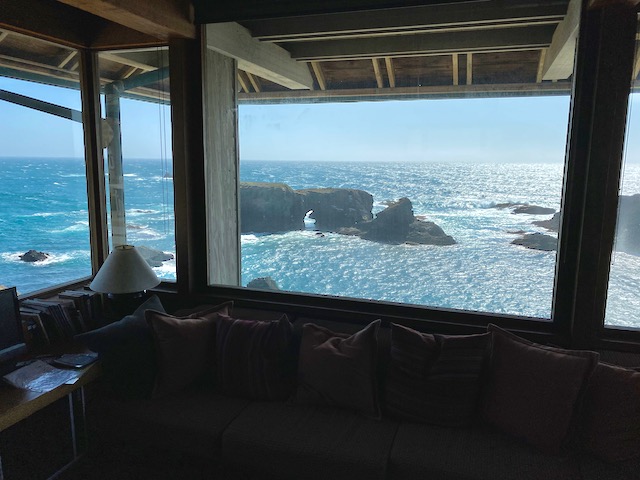
So that’s pretty cool.
Day One.
The obvious route is I-5 to CA-20. It’s a perfectly serviceable route, fine if you’re trying to get from point A to point B in as little time as possible.
That part of I-5 is also one of the most boring stretches of road in the U.S. West. I can’t imagine going that way except under extreme duress, like trying to escape a zombie horde.
Another route is across 199, through Grants Pass, Crescent City, and down through Eureka to Fort Bragg (not this one) and down to Mendocino. That’s a fine route; we’ve taken it a few times over the years from the Bay Area to Ashland, when we wanted a somewhat longer, more scenic drive.
But there’s a part of 101 called Last Chance Grade, which regularly washes out a long portion of the road, cutting off access along 101 (and the rest of the coast) between Crescent City and Eureka. The detour goes through…Grants Pass, Ashland, and Redding.
Last Chance Grade washed out in February, and CAL-DOT is still working on re-opening it both ways. A complete replacement will cost somewhere between $300 million and $2 billion, and may include tunneling. There are large chunks of time when it’s simply closed right now, open for one-way traffic for one-hour blocks a couple of times each day, then closed at night. Planning a trip along that route felt like a bad idea.
Another way to go is a short chunk of I-5 to Hornbrook, then CA-96 through Happy Camp, down to CA-299, and into Eureka.
CA-96 is reportedly a very scenic route. Two downsides: there was a HUGE wildfire there in 2020, and additional large fires in prior years, so much of the national forest west of 96 is closed. Grim to drive through.
The second factor is that gasoline is scarce through that area. I’d want to be more sure about my fuel burn before trying that path; it’s about 200 miles between known operating gas stations, at Hornbrook and Eureka. Once, on a long drive from Portland through Bend, we got low on fuel coming down from Crater Lake and had to nurse it (i.e. coast) from north of Shady Cove to Medford. That’s one way to avoid speed traps, but I really didn’t want that or worse on this trip. Maybe I’ll pack a plastic bag full of gas as a backup and try it later.
That left CA-3 south from near Hornbrook to Weaverville, through Shasta-Trinity National Forest. On the map, it looks like a relatively straight shot to Weaverville, then CA-299 to Arcata. We were staying overnight in Eureka; I’ll get to that later.
Did I mention that our cars are possessed?
Yeah, it’s a thing. Our cars like to drive; if we haven’t gone for a longish trip, at least to Medford or so in a while, the car will “arrange” it.
For example, a couple of weeks ago I was driving our red Volvo wagon. People see “red Volvo wagon” and think “mom-mobile”, but this is a car from the late 1990s when Volvo was still making racing cars; this one has a high-pressure turbocharger, 240bhp, Z-rated tires and brakes and suspension to match. A very fun car for long-distance driving.
So I was out getting her to the local car wash, the one down by exit 14, and noticed she needed gas. Normally I’d just have gotten it there, but, being the kind of guy who also shops for toilet paper prices (it’s a guy thing), I looked up gas prices on Gas Buddy and noticed that the Arco across the street had slightly lower prices. Sounds like a plan.
That Arco is like the entry funnel for a pest trap–it’s really easy to get in, but there’s no way out. Well, there is of course a way out, but it’s really hard to get out without getting on to I-5.
Which was the car’s plan all along.
So I got a nice unplanned drive down I-5. Oops, no exit at exit 11. Wait, what do you mean exit 6 is closed? Am I going to California by car for the first time in maybe a decade because the Volvo wanted a long drive? Oh, okay, exit 6 is open, but not the ramp back on to I-5. Fine. So we’re headed for a very scenic drive down Old Siskiyou Highway. This was apparently the main road across the pass before I-5. Really nice, swoop-y drive among the trees. A fine, if unexpected, route for a casual drive.
A while ago I had planned a non-highway drive to Portland. While we didn’t do that trip (yet), I wanted a similar experience for this drive, so on the day we headed to Eureka, I decided we’d take that same road as far south as possible. It was really cold that day; there was snow falling as we got into the higher elevations.
Oops. Did I mention that I forgot to check if the on-ramp to I-5 south (there is no other way across the pass) was open? Yeah, no, it’s not. So we get to the exit and–back north on I-5 to exit 11 at the south end of Ashland. Lovely scenic drive to nowhere.
Eventually we made it down to CA-96 and then CA-3. Nice, somewhat winding road down to Weaverville. Top up for the highway portions, and then top down as soon as the weather allowed. Whee!
Most of the time when I drive my cars, if the cautionary speed limits are, say, X, I’m comfortable with X+10 or over if the weather is good and the road is dry, and traffic is light or none: I know the vehicles from long experience, how they handle, etc. It’s fine, ma. Good brakes.
As you get closer to Scott Mountain however, it gets twisty. Really, really twisty. Even I was slowing down, because sliding down a long steep embankment is not a fun way to start a holiday. Beautiful scenic vistas.
The roads in California, by the way, are really well-paved right now. I was looking on Google Maps (yes, obsessive) at the street view images to get a sense of the road conditions, checking for gravel roads or other undesirable conditions. All of the roads looked okay, at least two lanes and concrete or paved. When we actually got there, it seemed like all of the roads had been freshly repaved in the last year or so. Nice clean blacktop and fresh striping. Great driving!
The plan had been to pack a lunch (the fourteen days on our second jabs wasn’t up quite yet). and stop along the way. Since this whole trip was a surprise for Herself, including the destination and route, she didn’t know what the plan was. I had picked a spot with a view of Trinity Lake, on the southwest edge of the western arm of the lake.
The unexpected detour at the start of the trip scotched that plan; we arrived at the picnic spot way late. Lovely scenic vista; next. Keep the tank filled, just in case.
It turns out California is doing a lot of roadwork while traffic is somewhat lighter. We had to stop three or four times along this part of the route, from Ashland to Eureka, where there was one-way traffic due to road repairs for rock slides. Better to be stuck in traffic than under the slide.
The other advantage to this route was that it concealed the destination (California coast) until well into the second day; Herself is game enough to play along and not check her phone’s maps to see where we were. Even in Eureka, since we were coming in from the Arcata side, you don’t see the Pacific at all.
I’m not sure we had ever stopped in Eureka before. This time, we were staying overnight at a lovely rental we found on AirBnB. Good location, walking distance to some nice restaurants, including this one where we had our first post-vax outside dinner.
The house’s backyard:

Day Two.
Today would be interesting.
We’d been down (or up) 101 a couple of times before, so we had a sense of how it would go.
Have I mentioned the navigation system in the car?
It’s a little dated; almost everyone uses phones these days, but I’m a fan of the built-in system because it has a cool heads-up display that shows useful data like speed limits, exits, and distances.
No, not this:

Ours is more like this:

Still pretty cool!
But the car has it’s own ideas about what’s fun. This time, it showed up as an option in the navigation system: “Avoid Highways”.
Sounds innocuous, right? Get off the highways, find a nice little side road, maybe a frontage road, maybe roads like 99 that go through towns, see a little more of the countryside.
Now, I couldn’t tell you what road we were actually on as we went south out of Eureka. We were on I-5 for a while; there are a couple of places where it’s the only way out of town. The nav system was polite enough to warn us that it couldn’t quite avoid all highways, and would that be acceptable? Then we got off I-5, and the road was again a nice two-lane road for a while.
Then we started to cross small bridges marked “Narrow Bridge”, followed by more two-lane roads.
Then the bridges were marked “One-Way Traffic”.
Then the bridges weren’t marked.
Then the road wasn’t striped at all–paved, yes, but striped, no, and getting narrower.
And going up, and up, and up. Weren’t we supposed to be along the coast?
Up and up, but we were still going past houses, and farm buildings, and the road stayed paved. Herself noticed that we were passing farm buildings at the lower heights, and then really fancy houses higher up. I was focused on what was left of the road. So, all good.
And then the road started going down.
And then is was striped again. Yay!
Look, another car coming our way, probably wondering who the nut coming at them was.
And then we were in Fortuna, gassing up again, and wondering just where the heck we’d been.
Oddly, I can tell you the length of that drive: 21 minutes, 13 seconds, give or take. I know this because, as we started to cross one of the first single lane bridges, the car started to play the “Thunderball Suite” from a James Bond CD. Lots of ominous passages, the occasional “da da da dum” staccato sequence, just perfect for this drive into strange places.
It was an adventure, and wasn’t that the point of the trip?
Eventually we got to Mendocino, and the house in Little River. I’ll skip most of the rest of the drive, much of which was along Avenue of the Giants. If you’re going along that part of 101, it’s definitely worth getting off 101 and take the side road there. Nothing scary, except for a little bit at the northern end, outside the national forest, where the appropriate soundtrack might have been “Dueling Banjos” from Deliverance.
Oh, yeah, there was another bit.
Earlier I had written that, when I see those cautionary speed limit signs, I’m okay with taking curves a little faster.
As we were driving from Leggett to Mendocino, we decided–okay, I decided–to take CA-1. Historic, scenic, a beautiful drive.
With a lot of curves.
With curves marked “30”, it’s okay to go a little fast.
With curves marked “25”, I found it prudent to slow down a bit more. Tighter curves, slower speeds. That’s okay, lots of nice scenery.
When the curves were marked “15”, even I was going about 15. Very tight curves, narrow, usually with a steep drop on one side and a rock face on the other. Shoulders? Please.
When we got to a curve marked “10” somewhere along CA-1, and I only remember one marked that way, we were totally crawling. That curve is more like a conveyor belt in an airport baggage handling system; a place where no human is meant to be. It turned and dropped and twisted in a way I’ve never seen and can’t properly describe here.
Then we were out, and rolling into Mendocino.
The rest is another story for a later day.